What Is Spock's Star Trek Hand Sign Called & What Does It Mean?
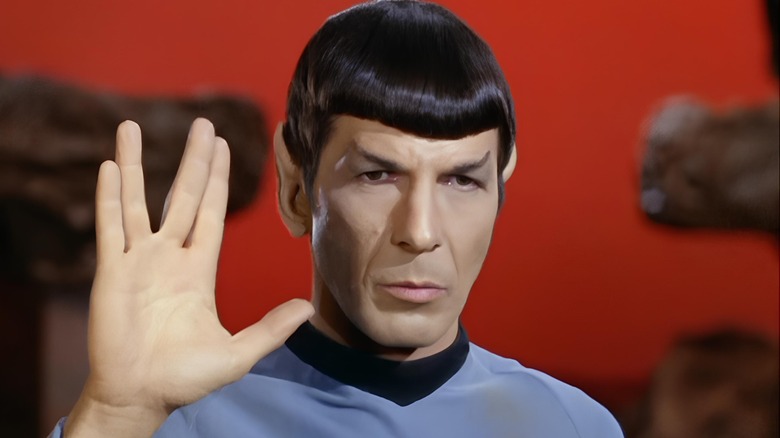
There is no more iconic hand gesture in pop culture than the split-fingered greeting used by Spock (Leonard Nimoy) and other Vulcans in "Star Trek." Usually accompanied by the phrase, "Live long, and prosper," the gesture requires splitting one's fingers between the middle and ring finger while extending the thumb, with the palm facing forward. But while many fans have seen it used throughout "Star Trek," many don't know its name, let alone its origins.
Spock's gesture is known as the Vulcan Salute. It was first seen in the episode "Amok Time," the episode of "Star Trek: The Original Series" in which Spock returns to Vulcan to compete in a mating ritual. Though not originally in the script for that episode, Nimoy felt it would be a good way to add more depth to Vulcan culture. "I suggested to the director that there should be some Vulcan thing that Vulcans do when they greet," Nimoy said in an Archive of American Television interview preserved by FoundationINTERVIEWS on YouTube. It was one of many aspects of Vulcan culture improvised by the actor . But the star clarified that the episode's writer, science fiction author Theodore Sturgeon, had come up with the phrase, "Live long, and prosper."
So, that's what the Vulcan Salute means within the universe of "Star Trek." But for Leonard Nimoy, it had a far more profound personal meaning rooted in his Jewish upbringing.

Leonard Nimoy's Vulcan Salute took inspiration from an ancient Jewish tradition
Leonard Nimoy, who played Spock on "Star Trek: The Original Series" and elsewhere, was raised in a Jewish household in Boston, Massachusetts, as the child of Ukrainian immigrants. His parents were observant, particularly his father, who brought his son along to High Holiday services at their local Orthodox synagogue. There, Nimoy witnessed a ritual that would go on to inform his Vulcan Salute.
Synagogue services on major holidays include the Priestly Blessing. Members of the priestly class of Kohanim — in the most simple terms, those with last names like Cohen and derivations thereof — bless the congregation by lifting their hands with the split-fingered gesture. The difference is that, in performing the Priestly Blessing, both hands are raised.
Crucially, members of the congregation are instructed to avert their gaze while the Blessing is recited, as the priests are said to be channeling the divine presence. Congregants often cover their faces with a tallis, a ritual shawl worn during prayer. But young Nimoy was much too curious to remain under the veil, so he would peer out at the Kohanim from under his father's tallis.
As noted on the Star Trek website, Nimoy wrote, "There were a group of five or six men facing the congregation and chanting in passionate shouts of a Hebrew benediction ... My dad said, 'Don't look.' ... I peeked. And when I saw the split-fingered gesture of these men ... I was entranced. I learned to do it because it seemed so magical. It was probably 25 years later that I introduced that gesture as a Vulcan greeting in 'Star Trek' and it has resonated with fans around the world ever since. It gives me great pleasure since it is, after all, a blessing."

Vulcan finger-touching
- View history
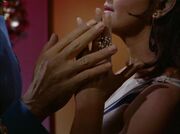
Vulcan finger-touching between Spock and a Romulan commander
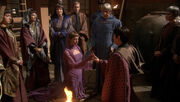
Finger-touching at a Vulcan marriage ceremony

Saavik assisting the regenerated Spock to endure pon farr
Vulcan finger-touching was a ritualistic gesture among Vulcans involving the index and middle fingers. It was used throughout their culture, including in public as a greeting or to signify affection, intimacy, respect, or meditation. It was also used at reunions, at wedding ceremonies, and during the pon farr . Contact ranged from a simple two-fingertip touch to tracing around another's hand.
If a Vulcan was bonded with a member of another species, the non-Vulcan would adopt the practice. The Romulans also had knowledge of the ritual, and it could be used as a greeting or a sign of interest. It could also be used as part of a meditative practice to center and control one's emotions or to purge them. ( TOS : " Journey to Babel ", " The Enterprise Incident "; Star Trek: The Motion Picture ; Star Trek III: The Search for Spock ; ENT : " Home ")
Notable occurrences [ ]
The instances in which Vulcan finger-touching was used included the following examples:
T'Pol and Koss during their wedding on Vulcan in 2154 . ( ENT : " Home ")
T'Pol and Koss upon greeting each other later that year. ( ENT : " The Forge ")
Sarek of Vulcan and Amanda Grayson of Earth on a diplomatic mission aboard the USS Enterprise in 2268 . ( TOS : " Journey to Babel ")
Spock and a female Romulan commander on her flagship later in 2268. ( TOS : " The Enterprise Incident ")

Spock performing finger touching during meditation on Vulcan, 2270s
During Vulcan meditation, Spock used finger touching as part of his meditation practice to expunge his emotions through Kolinahr . ( Star Trek: The Motion Picture )
A young, revived Spock, who was entering pon farr , with Saavik on the Genesis Planet in 2285 . Spock used the gestures she taught him while attempting to center his mind and emotions. ( Star Trek III: The Search for Spock )
Hallucination [ ]
While trapped in the Delta Quadrant in 2375 , a telepathic pitcher plant made the crew of USS Voyager believe they had returned to the Alpha Quadrant . Tuvok imagined that he was reunited with his wife T'Pel and greeted her in this manner. ( VOY : " Bliss ")
Background information [ ]
Regarding the origins of the Vulcan gesture involving touching of two fingers with two fingers, Leonard Nimoy explained in his book I Am Spock that the gesture was not meant to be the Vulcan equivalent of a Human kiss , but rather the Vulcan equivalent of holding hands in public: " The question came up as to what public sign of affection, if any, Sarek and his Human wife would display. Handholding was clearly out, but perhaps finger-to-finger contact of a ceremonial, dignified nature might work. Mark [Lenard] and Jane [Wyatt] took my comments to heart, and came up with the wonderful gesture where Amanda rests her first two fingers lightly upon Sarek’s two fingers. It worked beautifully, and added to the texture of [the episode]. " Nimoy also described Vulcan finger-touching as "the beginning of the Vulcan mating ritual", "the Vulcan two-fingers-touching 'embrace'", and "the Vulcan version of foreplay". ( I Am Spock , hardback ed., pp. 71-72, 237)
According to Harve Bennett , Leonard Nimoy imagined that, as a seven-year-old, Spock had engaged in some Vulcan finger-touching upon first meeting his betrothed, T'Pring . Nimoy related this concept to Bennett while they were writing Star Trek III: The Search for Spock . ( Star Trek: The Magazine Volume 3, Issue 8 , p. 31)
While filming the Vulcan finger-touching with Saavik actress Robin Curtis for Star Trek III: The Search for Spock , Stephen Manley , portraying the seventeen-year-old Spock, grabbed Curtis' hands with both of his hands, an improvised gesture intended to portray passion. Leonard Nimoy, as the film's director, strongly approved of this moment, even fighting for it to remain in the movie when the executives at Paramount were eager to edit it out because it was eliciting a lot of laughs from viewers who weren't entirely familiar with Star Trek . Manley was extremely grateful for Nimoy insisting on the scene remaining. At photo opportunities during Star Trek conventions from 2005 onward, Manley would typically hold his fingers touching those of female fans who wanted a picture taken with him. ("Spock: The Early Years", Star Trek: Motion Picture Trilogy (DVD) / (Blu-ray) special features)
A scene in the script of unmade movie Star Trek: The First Adventure involved Spock, as a cadet, teaching a stripper how to do Vulcan finger-touching. The script's stage directions identified this gesture as actually being pon farr .
In the first draft script of ENT : " Fusion " (which had the working title "Equilibrium"), Vulcans T'Pol and Szon did some finger-touching during a dream T'Pol experienced. This finger-touching was to have taken place in Enterprise 's mess hall , empty apart from the pair, and was described in the teleplay's stage directions thus: " Szon moves to her, reaching out two fingers in a traditional Vulcan gesture. T'Pol presents the back of her hand to him, and Szon presses his fingers against her flesh… T'Pol reacts to the sensual touch. " In the dream sequence, the finger-touching preceded a very sensual mind meld between the couple.
The writers of the film Star Trek debated, among themselves, about the possibility of having Spock and Uhura finger-touching in a turbolift scene from that movie. Ultimately, J.J. Abrams pointed out that such behavior would be unfamiliar and consequently puzzling to a new audience, so the pair of characters instead kiss in the same scene. In a Q&A, Roberto Orci and Alex Kurtzman agreed with this conclusion. [1]
- 2 ISS Enterprise (NCC-1701)
Emoji dictionary
🖖 vulcan salute emoji.
[ vuhl -k uh n s uh - loot ih- moh -jee ]
What does 🖖 Vulcan Salute emoji mean?
Live long and prosper, friends! If you ever need to spread the love to your geekier friends, then flash a 🖖.
The Vulcan salute emoji, 🖖, is perfect for showing your Star Trek cred or sci-fi pride more generally.
Related words
Where does 🖖 vulcan salute emoji come from.
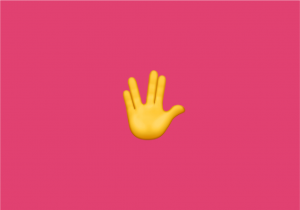
The Vulcan Salute emoji is officially called the raised hand with part between middle and ring fingers emoji. And, that’s exactly what the emoji shows across platforms. Its default hue is yellow, but skin-tone modifiers allow users to change color. It joined emoji keyboards under Unicode 7.0 in 2014.
The emoji commonly goes by the Vulcan salute because the gesture was popularized by Mr. Spock (Leonard Nimoy), who used it as a greeting in the sci-fi franchise, Star Trek . Nimoy first used the gesture in the 1967 TV episode “Amok Time,” in which Spock comes into contact with other members of his Vulcan race.
Nimoy wanted the Vulcans to have a way of greeting one another similar to human hand gestures. In an interview with New York Times , Nimoy said that his Vulcan salute was inspired by a gesture that he witnessed during a Jewish religious service when he was a boy. Jewish priests perform the actual religious gesture with both hands to form the Hebrew letter shin , ש.
The greeting Live long and prosper! has also accompanied the Vulcan salute ever since its debut in “Amok Time,” also inspired by Jewish scripture, with Deuteronomy 5:33 being the most cited inspiration for the phrase.
The Vulcan salute went memetic almost immediately after Nimoy’s first usage of the gesture. According to Nimoy, mere weeks after “Amok Time” aired, people were already using the gesture to greet him everywhere he went. The gesture was first popular among Star Trek fans but the gesture’s similarity to the popular V-shaped peace hand gesture (✌️), both in finger placement and good-willed intent, helped it catch on outside that community.
The Vulcan salute was popular long before the rise of social media, so it comes as no surprise that the emoji version took off right away after Unicode added it on June 16, 2014.
🖖 — Kim Ahlström (@Kimtaro) June 16, 2014
Prior to that day, users had to make due with typographical substitutes.
@pruet \V/_ Vulcan salute — Keng ☂ (@kengggg) November 14, 2007
Examples of 🖖 Vulcan Salute emoji
Who uses 🖖 vulcan salute emoji.
The Vulcan salute emoji is used anytime someone wants to flash the greeting and good wishes. It can be Star Trek fans …
Happy Birthday to our Trekkie Girl Carole! Have a trektastic day! 🖖 🍸🍾 — Trekkie Girls (@TrekkieGirls) October 17, 2016
Live long & prosper. Trekkie and proud 🖖 pic.twitter.com/omklaAa5ak — Lola Dreambomb (@Lola_Dreambomb) July 22, 2016
… or your non-Trekkie but self- avowed nerd friends. In this vein, the emoji can suggest anything “geeky” or “far out.”
Happy birthday nerd. May you live long and prosper 🖖 in Jesus name. God bless you homie @J_Anowa — Bruce Wayne💰💵 (@Bizzle025) July 16, 2018
embrace the martian 🖖 — Genius (@Genius) July 17, 2018
The Vulcan salute emoji is also commonly used when tweeting about (or to) actors that appeared in Star Trek.
Happy 78th Birthday to Patrick Stewart …🖖 pic.twitter.com/bgA4gsL0Bg — Phil Murphy (@crashtesterX) July 13, 2018
George Takei knows the score. 🖖 https://t.co/qInzV1IRsH — Ross Colquhoun (@rosscolquhoun) June 24, 2016
William Shatner is in Lowell today 🖖 — V. Arun (@A_Venugopal_97) June 11, 2015
While the Vulcan salute emoji is widely used when discussing anything Star Trek related, such as old episodes or new films, it can also mark content dealing with science fiction works in general.
🤔 Like anyone could possibly just rank their favorite all-time episode @StarTrek ?!? Ridiculous! #TrekRanks 🖖📊 https://t.co/KYzfPRXacD — TrekRanks Podcast 🖖📊 (@TrekRanks) July 24, 2018
For all who love Sci-Fi movies that really fuck with your head and concept of reality/time, watch 'Arrival' .. great movie, still confused as tits 10/10 wont sleep tn 👍🖖 — MariJane (@mariman777) July 25, 2018
This is not meant to be a formal definition of 🖖 Vulcan Salute emoji like most terms we define on Dictionary.com, but is rather an informal word summary that hopefully touches upon the key aspects of the meaning and usage of 🖖 Vulcan Salute emoji that will help our users expand their word mastery.
- By clicking "Sign Up", you are accepting Dictionary.com Terms & Conditions and Privacy policies.
- Email This field is for validation purposes and should be left unchanged.
Other categories
- Famous People
- Fictional Characters
- Gender & Sexuality
- Historical & Current Events
- Pop Culture
- Tech & Science
- Translations
Star Trek: When the Vulcan Salute First Appeared (and What It Means)
Leonard Nimoy created the famous Vulcan salute for Star Trek, but no one could've anticipated just how popular it would become.
Aside from the pointed ears, Mr. Spock's Vulcan salute may be his most iconic feature. The gesture has become synonymous with Star Trek , to the point where fans use it as a standard greeting and subsequent sci-fi efforts like Mork and Mindy satirized it. There are even plans to build a statue honoring the salute in Nimoy’s hometown of Boston. And yet, it was a late addition to the original series , and only came about because Leonard Nimoy had a moment of inspiration.
Nimoy first used the salute in Season 2, Episode 1, “Amok Time,” as a means to express greeting. It was conceived of on the spot during rehearsals, and while Gene Roddenberry subsequently attempted to claim credit for its invention, Nimoy has since recounted its origins in ancient Jewish tradition. He didn’t know that it was going to become a part of Star Trek when he used it, but considering its significance, the connection is quite fitting.
RELATED: Star Trek's Longest Running Series, Revealed
"Amok Time" Defined the Vulcans
“Amok Time” is widely cited as a foundational moment for the cultural development of the Vulcans. Spock is overcome by the effects of pon farr, and must return to his homeworld before it kills him. It was fans’ first opportunity to see Spock’s culture directly, and the character’s popularity turned many of its tropes into accepted Vulcan traits. According to Nimoy, he simply wished to use an appropriately alien hand gesture to greet T’Pau who, as a judge and official over the proceedings, merited proper respect.
The salute had no significance beyond the immediate needs of the scene, but its ease of use meant that Nimoy could repeat it as a kind of shorthand -- along with the trademark “live long and prosper” -- anytime it felt appropriate. Fans began to emulate it for the same reasons, and soon it became an essential part of Star Trek. Adding further intrigue was the fact that some people struggle to make the gesture, with slight mechanical differences in individual hands making it more difficult. In preparing to take on the role of Spock in J.J. Abrams' reboot, Zachary Quinto even confessed difficulty in making the salute, requiring practice for him to perfect it. That odd quirk lent the salute an instant mystique that played into Mr. Spock’s identity perfectly.
RELATED: Star Trek: There's a Good Reason 'The Man Trap' Was the Series' First Episode
The Vulcan Salute Stems from a Jewish Ritual
The gesture itself comes from a blessing in the Jewish faith, made daily to the congregation. The Kohanim priests connect their thumbs and make the sign with both of their hands, which forms the Hebrew letter “shin”, the first letter used in a name for God. Its use as a blessing makes an ideal match for the Vulcans’ benevolence and wisdom and roots their overall spirituality in an actual religious tradition.
The particular circumstances under which Nimoy first saw the symbol bear mentioning as well. According to the actor's account on StarTrek.com , his father told him not to look as the priests conducted the blessing (the congregation should be contemplating God instead of watching the priests.) Nimoy says that he looked anyway, and saw the priests making the sign. It felt magical to him, and he learned how to do it because of his fascination with the gesture. Star Trek inadvertently amplified that fascination and made it a key component in one of the franchises’ most beloved species.
KEEP READING: Picard: Patrick Stewart, John De Lancie Tease Q's Star Trek Return
- More to Explore
- Series & Movies
Published May 10, 2023
This is Why We 'Live Long and Prosper'
In honor of Jewish Heritage Month, we're looking back at the history behind the Vulcan Salute.
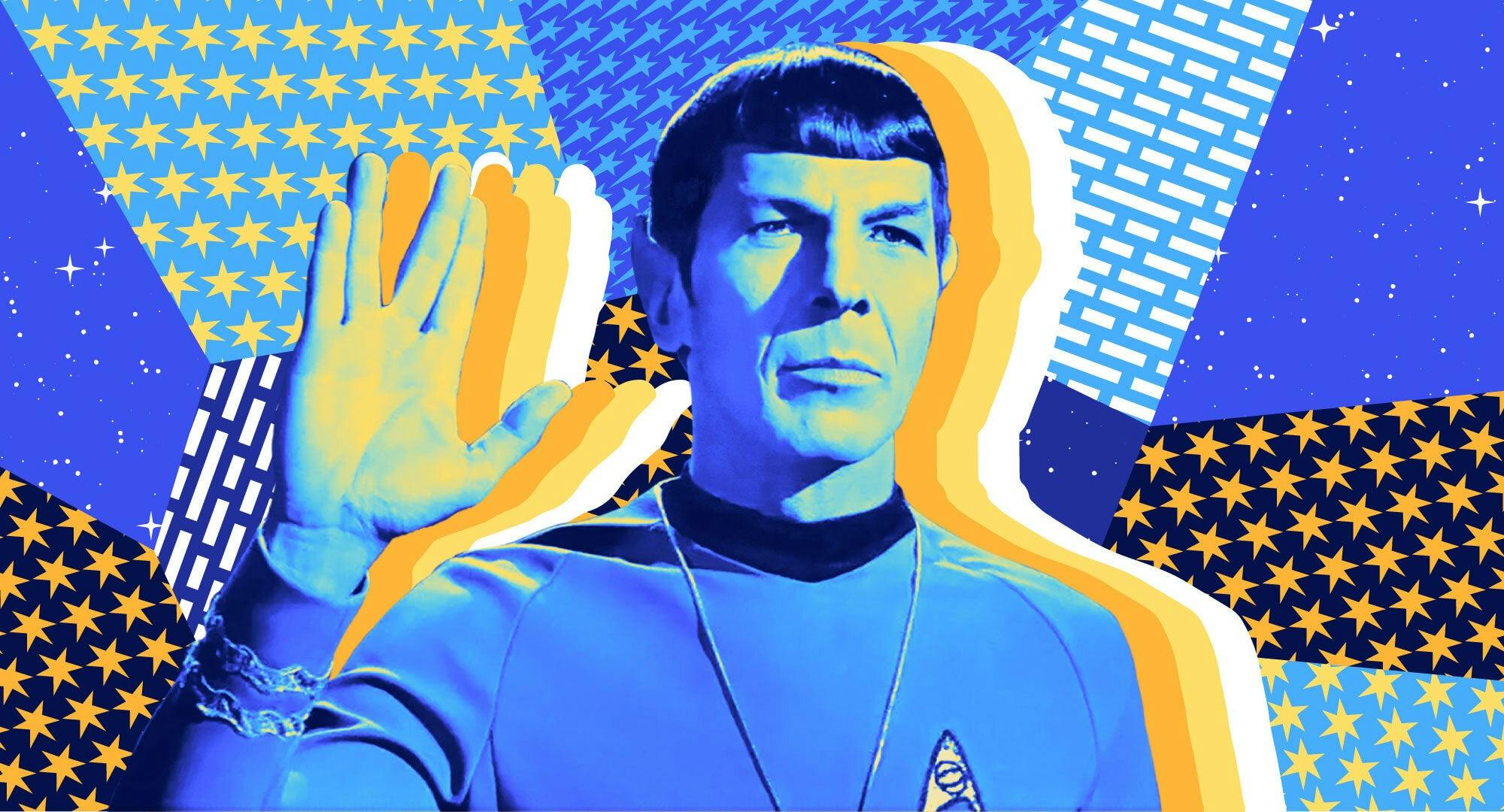
StarTrek.com / Rob DeHart
" Live Long and Prosper ."
These words are immediately recognized and associated with Star Trek and its fandom, and the Vulcan salute is an even more recognizable extension of that phrase. The salute’s origin, however, doesn’t come out of the vast final frontier, but instead from Leonard Nimoy’s Jewish heritage.
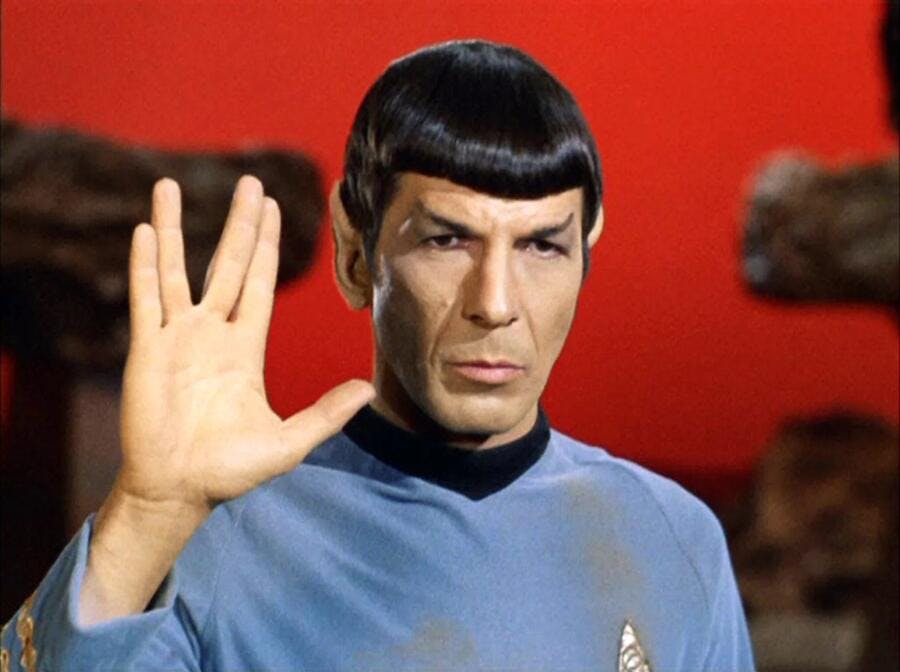
StarTrek.com
Gene Roddenberry’s mission for Star Trek was always to tell stories that included elements from a diversity of cultures, be they alien or of Earth. When Leonard Nimoy had an idea for a Vulcan greeting, Roddenberry let him bring along a piece of his culture. Nimoy introduced the hand sign of the Kohanim Jewish blessing, which would become the Vulcan salute.
In a project for the Yiddish Book Center , Nimoy recounted the story of the first Star Trek episode where Spock visits the planet Vulcan in the Season 2 premiere, " Amok Time ." Spock was to visit his home planet to be married, and it would be the first time another Vulcan would be seen on-screen. After considering the the greetings people have across cultures, Nimoy thought the Vulcans should have their own.
Though most of us immediately recognize the salute as the Vulcan greeting, its true origin comes directly from the Torah. It represents the Jewish Priestly Blessing of the descendants of Aaron. Aaron is the Jewish High Priest, and the sons of Aaron are Priests, or the Kohanim .
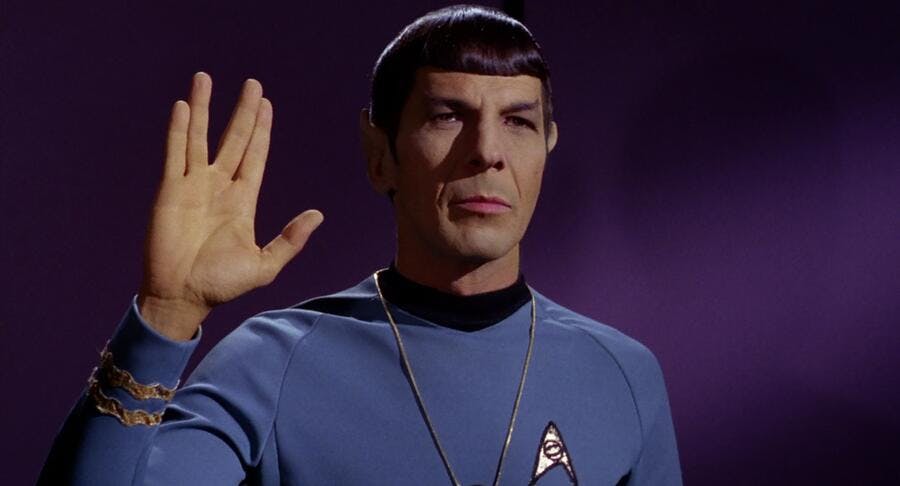
I chatted with Rabbi Morrison of Beth Emeth Synagogue in Toronto, Ontario , an expert on both Judaism and “nerd TV culture,” who told me more about the origin of the salute. “When the Kohanim do the Priestly Blessing, they take their two hands and bring the thumbs together and it’s like the ‘Live Long and Prosper’ sign.”
The version in the blessing differs slightly, Rabbi Morrison continued, “[Spock] only does it on the show with the one hand, but the Kohanim , when they do the blessing, take the two hands, connect the thumbs to make the Hebrew letter 'Shin.'” Shin is the first letter of Shaddai, one of the names given to G-d in the Torah. [ Writer's Note : As Jews, we are not to type, write, or say the word for god — capitalized — unless in an in-context blessing .]
The hand sign is done during the performance of the blessing by the Kohanim who stand at the front of the sanctuary and bless the congregation. Historically, this was done daily in the Beit HaMikdash, the Holy Temple, when it stood in Jerusalem . “You needed the Kohanim and their officiating to be able to fulfill certain Jewish practices,” Morrison said, “Now, the blessing is done ‘symbolically’ by the Kohanim daily in Israel, and outside during festivals.”
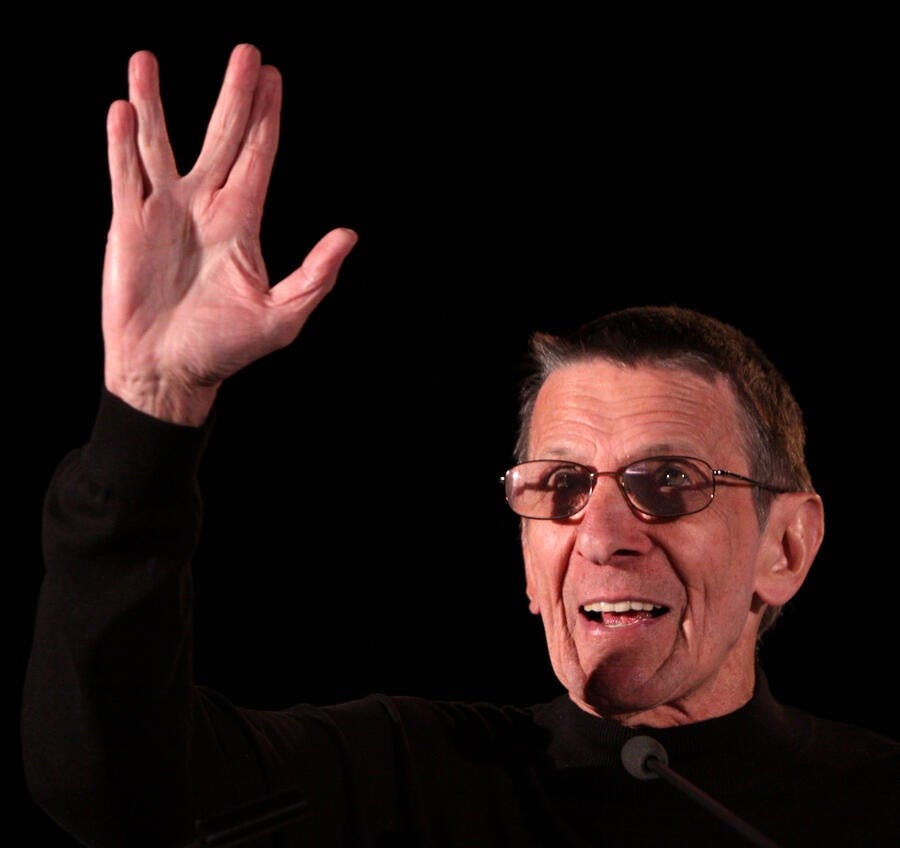
Gage Skidmore
The words in the blessing itself are part of the Amidah , the daily prayers, but the sign we know as the Vulcan salute is only done when the Kohanim are called upon to stand before the congregation and recite them.
The Lord spoke to Moses, "Speak to Aaron and his sons,This is how you bless the people of Israel, say to them,'The Lord will bless you and protect you,the Lord will go kindly and graciously with you.The Lord will bestow his favour upon you and grant you peace.'Thus, they shall link my name with the people of Israel, and I will bless them."— Bemidbar, Chapter 6, Verses 22-27
Though Jewish fans of Star Trek might be thrilled by the addition of something so deep in our culture, many of us have never seen the hand sign used in religious practice. When the Kohanim perform the blessing and show the salute, the congregation is meant to turn away.
Per Rabbi Morrison, “You’re not supposed to look when the Kohanim do the blessing and ‘salute’ because you are supposed to be focusing on the words and thinking of G-d as opposed to focusing on the people saying the words.” There are varying beliefs as to why one should turn away, Nimoy was told you could die for seeing the feminine side of G-d appearing during the blessing. “There are some who believe that if you look, you will go blind, but the idea is that the focus should be on hearing the words and internalizing the meaning of the words and not looking at the Kohanim who are doing it. But neither Nimoy or I could help ourselves — we peeked."

The Spock actor recalled a time he attended synagogue and his father told him not to look when five or six men went to the Bima (the raised platform at the front of a synagogue where readings are done) and began shouting a blessing. He knew something “major” was happening; so, young Nimoy peeked to see those men with their hands poking out from their Tallit (a scarf like garment worn by Jews, draped over their heads during this blessing) in a striking hand sign that he thought was “magical.”
Years later, Nimoy would suggest this magical hand sign extend from his personal heritage to that of his character. Though Nimoy could flash the sign with ease, not every Vulcan could. Celia Lovsky, who played T’Pau, the Vulcan Minister, was unable to do the sign on her own and had her fingers taped together for production. Zachary Quinto allegedly had some trouble with the salute and did some Vulcan finger exercises while preparing for his most logical role. It was said his fingers were glued together for production , but Quinto swears this is just a rumor . Though I can’t say for sure, I have a suspicion that Arlene Martel, who played Spock’s bride-to-be, T’Pring, a fellow Eastern-European Jew , could probably flash the sign with ease.
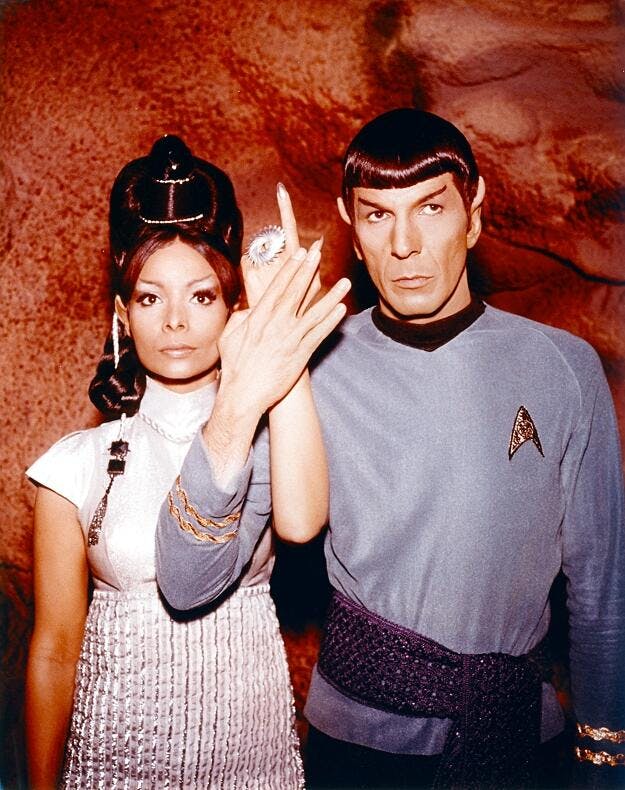
This notorious hand sign has become a salute for Star Trek fans worldwide. This one element added a layer to what Gene Roddenberry did — ensuring diversity on-screen and allowing the actors to bring elements of themselves to the characters. For Jewish Trekkies like me and Rabbi Morrison, two incredibly important aspects of our lives get to intersect. “It brought all of my worlds together. It brought my TV world and my Jewish world together like they were one.”
This article was originally published on May 17, 2019.
Lindsay Traves (She/Her) is a writer based in Toronto where she lives with her dog, Spock. After submitting her Bachelor’s thesis, “The Metaphysics of Schwarzenegger Movies,” she decided to focus on writing about her passions which include sci-fi, horror, sports and comics. She’s been published in Grim Magazine, CBR, Nightmarish Conjurings and more. Follow her on Twitter @smashtraves.
Stay tuned to StarTrek.com for more details! And be sure to follow @StarTrek on Facebook , Twitter , and Instagram .
Get Updates By Email

- The Inventory
Support Quartz
Fund next-gen business journalism with $10 a month
Free Newsletters
The history behind Leonard Nimoy’s Vulcan salute
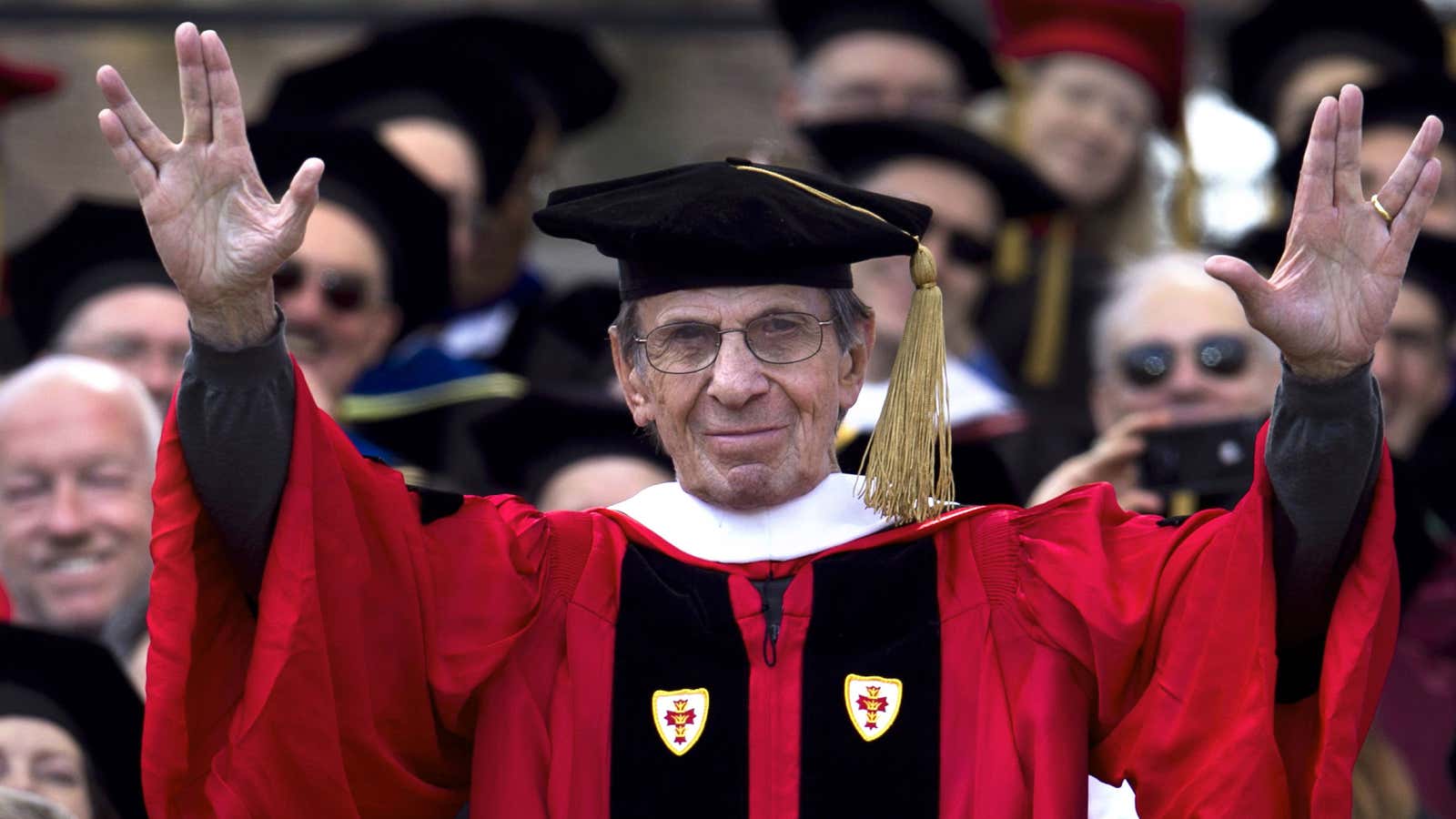
Leonard Nimoy’s passing at the age of 83 is prompting a flood of reminiscences about the actor, artist, and poet best known for his portrayal of the half-human/half-Vulcan Spock on the television series and movies Star Trek .
Many will remember him performing his trademark four-finger Vulcan salute, which the actor actually created himself:
Nimoy drew on his orthodox Jewish upbringing to invent the iconic hand gesture, and he wrote about the process of finding it in his memoir, I am Spock :
For what would soon become known as the Vulcan salute, I borrowed a hand symbol from Orthodox Judaism. During the High Holiday services, the Kohanim (who are the priests) bless those in attendance. As they do, they extend the palms of both hands over the congregation, with thumbs outstretched and the middle and ring fingers parted so that each hand forms two vees. This gesture symbolizes the Hebrew letter shin, the first letter in the word Shaddai, `Lord.’ … So it was that, when I searched my imagination for an appropriate gesture to represent the peace-loving Vulcans, the Kohanim’s symbol of blessing came to mind.
In a chat with the Baltimore Sun in 2000, Nimoy explained how he got the idea:
In the blessing, the Kohanim (a high priest of a Hebrew tribe) makes the gesture with both hands, and it struck me as a very magical and mystical moment. I taught myself how to do it without even knowing what it meant, and later I inserted it into “Star Trek.” There was a scene in one episode that needed something. People were seeing other members of the Vulcan race for the first time, and I thought it called for a special gesture.
📬 Sign up for the Daily Brief
Our free, fast, and fun briefing on the global economy, delivered every weekday morning.

Live Long and Prosper (Vulcan salute)

Live Long and Prosper is a now-famous hand gesture performed when two Vulcan characters either greet one another or take their leave. The phrase "Live long and prosper" is accompanied by this formal hand gesture. The (lesser known) response is "Peace and long life."
The single canon reference to this action being called a "salute" is in the episode "Journey to Babel", where Dr. McCoy asks Spock, "How does that Vulcan salute go?" Leonard Nimoy also calls this "the Vulcan hand salute" when he talks about it in interviews and documentaries. Fans generally refer to it this way as well. One very early example is this December 1967 reference: "Many thanks, and a Vulcan salute ... for suggesting [this] carbonzine become a fanzine ." [1]
In January 1968, the zine The Crewman's Log #5 had instructions on how to make "the Vulcan Salute" symbol with one's hands; it involved lots of practice and the application of "Scotch Tape" which one left on one's hand all day to "train your fingers."
Vulcan Pronunciation
There are at least three different versions of the Vulcan pronunciation of this phrase in common use:
- Dif-tor heh smusma is the version seen on most "official" Star Trek sources such as Memory Alpha ; it was first used in Star Trek: The Motion Picture (1979). [2]
- Mene sakkhet ur-seveh is often seen in fanfic, but is not canon for the TV show or films; it has a later origin in Diane Duane 's novel Spock's World (1989).
- In the early 1970s, many fans said "Peace and Long Life" as Pastak v'dora lashe . Joan Verba in her book Boldly Writing says these words came from a "joint effort among Michelle Malkin , Joyce Yasner , and Lee Smoire [presumably this was the Lee Smoire who was a long-time member of the Washington Science Fiction Association]."
- More ways to say Live long and prosper and understand the IDIC at the Vulcan Language Institute
The Hand Gesture in Canon
Back in the 1960s, hippies who watched Amok Time thought the salute was a variation of the two-fingered peace sign. But we Jews knew better. - Rabbi Yonassan Gershom [3]
The Vulcan salute was performed in canon for the first time in the Star Trek: The Original Series episode "Amok Time." Celia Lovsky as T'Pau is the first person viewers saw raising her left hand in the now-familiar gesture.
Leonard Nimoy writes in "I Am Not Spock" that he based the hand gesture on the "Priestly Blessing" performed by Jewish Kohanim, the priests of the Hebrew Tribes, with both hands. It represents the Hebrew letter Shin (ש), which has three upward strokes similar to the position of the thumb and fingers in the salute. The letter Shin stands for Shaddai, meaning "Almighty (God)". The words of the blessing are from Numbers 6:24-26: "May the Lord bless you and keep you," and so on. Nimoy says he was also told that the Shin invokes the Shekinah , the female aspect of God, and it is she who enters the temple and blesses the people, especially on Friday night, as the Sabbath begins.

Live Long and Prosper: Valediction Used by Fans
"Live Long and Prosper" (commonly: "L.L.& P.") is used by some Trek fans as a closing to letters and messages to each other. For example: "See you at the next con! L.L.& P., MPH." Leonard Nimoy signed all of his Twitters with LLAP.
On January 15, 2016, Dr. Philippa Whitford, the Scottish National Party's MP, spoke in the House of Commons supporting the establishment of Britain's first spaceport to be in Scotland. She concluded with the salute and the words "Live long and prosper."

On March 26, 2021, "Leonard Nimoy Day" in Boston, the city's Museum of Science announced plans to enshrine the Vulcan salute as a 20-foot stainless steel sculpture by David Phillips, to stand outside the museum. Nimoy was born in the West End, not far from the museum. [4]
The "live long and prosper' symbol represents a message that my dad believed so strongly in. My dad always loved Boston and he would be honored knowing that the Museum of Science would be the permanent home to this memorial. The sculpture not only depicts one of the world’s most recognized and loved gestures for peace, tolerance, and diversity, but it will also be a beautiful tribute to my dad’s life and legacy. - Julie Nimoy
The Hand Gesture in Fanon
The gesture was named the Ta'al by Margaret Wander Bonanno in Dwellers in the Crucible , and many fans have adopted this name. Diane Duane refers to it as "the parted hand".
Jacqueline Lichtenberg incorporates the gesture in the philosophies expressed in her Kraith series. Here, it is an expression of devotion to Surak's Construct. The thumb held apart from the other fingers represents reverence for privacy: the small finger, IDIC ; the third finger, Nome , meaning All; the middle finger, reverence for life; and the index finger, the doctrine of the Domination of Logic. [5]
The Hand Gesture Portrayed in Fanworks

inside front cover of Energize!

back cover of Plak Tow #6

front cover of Grip #4

inside Menagerie #10, Doug Rice

front cover of Images and Dreams #4

back cover of Saurian Brandy Digest #4

front cover of In a Different Reality #2

cover of Eridani Triad

back cover of Menagerie #11

cover of a convention program

from the back cover of Trexperts #42, Robert Bruce Lloyd

cover of Vootie #1

inside art of The Elder Brother , artist is Nan Lewis , Spock appears to give Christine Chapel some instruction
External Links
- Vulcan Salute on Memory Alpha
- ^ from Plak-Tow #1
- ^ Vulcan Language on Memory Alpha ; the pronunciation was coined by James Doohan ( Scotty ) as a phrase that could be lip-synced to the spoken words "live long and prosper" in English.
- ^ Rabbi Yonassan Gershom, Jewish Themes in Star Trek . Lulu, 2010.
- ^ " Live long in sculpture: 20-foot art planned for Spock symbol ." Associated Press, March 26, 2021
- ^ Surak's Construct at simegen.com.
- Star Trek Concepts
Navigation menu
new video loaded: Nimoy Explains Origin of Vulcan Greeting
Nimoy Explains Origin of Vulcan Greeting
As part of the yiddish book center wexler oral history project, leonard nimoy explains the origin of the vulcan hand signal used by spock, his character in the “star trek” series., remembering leonard nimoy.
Advertisement
NOW PLAYING
The Man Who Was Spock
Get JTA's Daily Briefing in your inbox
I accept the JTA Privacy Policy .
By submitting the above I agree to the privacy policy and terms of use of JTA.org
WATCH: Leonard Nimoy explains Spock’s salute
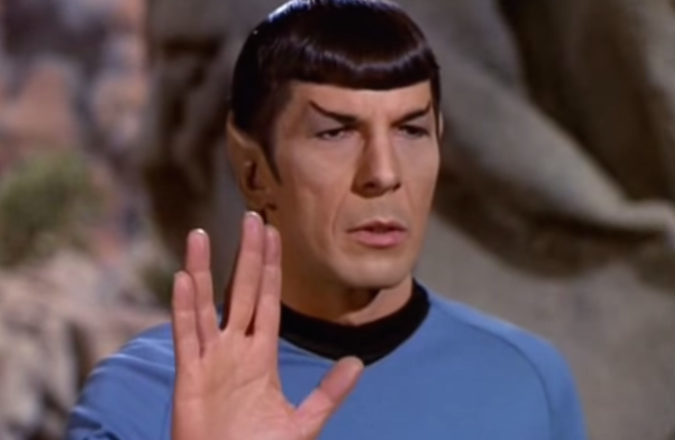
Leonard Nimoy, who played the overly logical part-human, part-Vulcan hero Spock on “Star Trek,” passed away Friday at the age of 83.
To quote Spock’s most famous recurring line, Nimoy certainly lived long and prospered.
Though he had a wide-ranging career that included acting on stage and screen, directing, and writing, Nimoy was (and will be) forever associated with Spock.
The character’s signature gesture, as most people with moderate pop culture knowledge know, was his split-finger Vulcan salute greeting.
The salute, which Nimoy devised himself, was taken from a Jewish prayer. The split-finger gesture represents the Hebrew letter shin.
In the video below, Nimoy digs deeper into the salute’s Jewish origins.
Share this:
Recommended from jta.
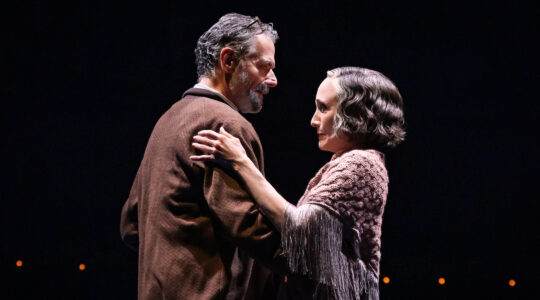
Steven Skybell’s Jewish story shines at the heart of Broadway’s ‘Cabaret’ revival

After Yale protest, prominent rabbi reiterates demand that anti-Israel activists not sing his song
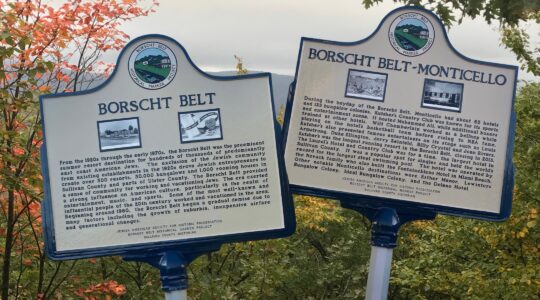
Seeking out sites from the bygone Borscht Belt? New historical markers lay out a path.

These young adult novels are expanding the way literature depicts Jewish teens

Generations of immigrants to the Lower East Side are celebrated in a new picture book

A fifth question this Passover: Why does that Manischewitz matzah box look so different?
The Significance And Meaning Of The Star Trek Hand Symbol
- Last updated Jul 26, 2023
- Difficulty Beginner
- Category Symbolism
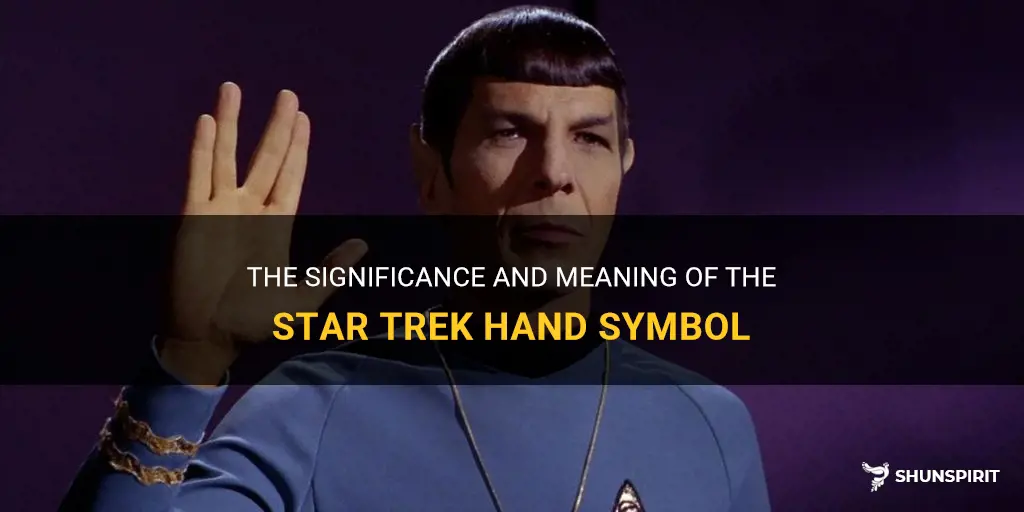
If there is one symbol that instantly transports us to the futuristic universe of Star Trek, it is the famous hand sign. With a simple gesture, the iconic hand symbol became synonymous with the famous greeting live long and prosper and came to represent the ideals of peace, logic, and unity in the Star Trek universe. But where did this symbol originate, and what does it truly mean? Join me on this journey to uncover the mysteries behind the Star Trek hand symbol, as we explore its historical significance and its profound impact on popular culture.
What You'll Learn
What is the origin of the star trek hand symbol, how did the star trek hand symbol become popularized, what does the star trek hand symbol represent in the show, are there any real-life meanings or origins to the star trek hand symbol, how has the star trek hand symbol been embraced by fans and pop culture outside of the show.

The hand symbol commonly seen in the science fiction franchise Star Trek has become widely known and recognized. The gesture, known as the Vulcan salute, is performed by raising the hand and separating the palm from the fingers, leaving only the middle and ring fingers together, while the index and little fingers remain extended. Also known as the "live long and prosper" sign, it has become an iconic symbol associated with the series.
The origin of the Vulcan salute can be traced back to the creator of Star Trek, Gene Roddenberry, and the actor who played the character of Spock, Leonard Nimoy. In the original Star Trek series, Nimoy's character, Spock, was half-human and half-Vulcan, a fictional alien race known for their logic and rationality. Nimoy wanted to incorporate a distinctive greeting for Vulcans that would reflect their unique culture and customs.
The inspiration for the Vulcan salute came from Leonard Nimoy's childhood experiences. He remembered attending a Jewish synagogue service where he observed a gesture performed by the rabbi when giving a blessing. The symbolic gesture involved the hands positioned similarly to the Vulcan salute, with the rabbi's thumb extended and touching his index finger. Nimoy found this ritualistic hand position fascinating and decided to adapt it for Spock's character as a way to emphasize the Vulcan culture's emphasis on logic and intellect.
When Nimoy approached Gene Roddenberry with the idea, the creator of Star Trek liked the concept and immediately incorporated it into the series. From that point forward, the Vulcan salute became an integral part of the Star Trek franchise, often associated with Spock's character and Vulcan culture as a whole.
The popularity of the Vulcan salute quickly spread beyond the boundaries of the show and became a recognizable symbol in popular culture. Fans of the series and non-fans alike started using the gesture as a greeting, a sign of solidarity, or simply as a way to express their love and appreciation for Star Trek.
The phrase "live long and prosper," often associated with the Vulcan salute, also originated from the Star Trek series. It was first used by Spock's character in the episode "Amok Time" and became one of his catchphrases. The phrase encapsulates the core values of the Vulcan civilization, which prioritizes knowledge, reason, and the pursuit of a long and prosperous life.
In conclusion, the Vulcan salute, or the iconic hand symbol from Star Trek, has its origins in Leonard Nimoy's childhood observations of a rabbi's gesture during a Jewish synagogue service. Nimoy adapted this hand position for his character, Spock, to symbolize the Vulcan culture's emphasis on logic and intellect. The Vulcan salute became a recognizable symbol in popular culture and is often associated with the phrase "live long and prosper," which epitomizes the values of the fictional Vulcan society.
What Does the UNK Symbol Mean and How is it Used?
You may want to see also
The Star Trek hand symbol, also known as the Vulcan salute, has become an iconic symbol in pop culture. It is often used as a greeting among Star Trek fans, and has even been adopted by famous personalities and celebrities. But how did this hand symbol become so popularized?
The Vulcan salute was first introduced in the original Star Trek television series, which aired from 1966 to 1969. The salute was developed by Leonard Nimoy, who played the character Spock, a Vulcan science officer on the Starship Enterprise. Nimoy wanted a distinctive greeting for his character, and took inspiration from a Jewish blessing he saw as a child.
The hand symbol itself is made by separating the middle and ring fingers, while the thumb is extended fully and the other fingers are closed. This creates a distinctive "V" shape with the hand. The gesture is accompanied by the phrase "Live long and prosper," which became synonymous with the salute.
When Leonard Nimoy first introduced the Vulcan salute on the show, it was not an instant hit. In fact, many people found it confusing and difficult to replicate. However, over time, the symbol gained popularity among Star Trek fans and became a recognized symbol of the franchise.
The popularity of the Vulcan salute reached new heights with the release of Star Trek movies and spin-off series. The gesture was often used by other characters in the Star Trek universe, further solidifying its association with the franchise.
Outside of the Star Trek fandom, the Vulcan salute gained wider recognition through various forms of media. It has been featured in popular television shows, movies, and even cartoons. The symbol has also been adopted by fans of the show as a way to identify themselves and show their love for Star Trek.
In addition, notable personalities and celebrities have also embraced the Vulcan salute, further contributing to its popularization. People like Barack Obama, Stephen Hawking, and Justin Trudeau have been spotted giving the salute at various events. This has helped to elevate the symbol's status and make it more widely known.
The Vulcan salute's popularity can also be attributed to its unique and distinct appearance. The "V" shape created by the hand symbol is visually striking and easily recognizable. Its association with the Star Trek franchise also adds to its appeal, as the show has a dedicated fan base that spans generations.
Overall, the Vulcan salute's journey from a simple greeting on a television show to a widely recognized symbol in popular culture is a testament to the enduring impact of Star Trek and its dedicated fan base. Its distinctive appearance, association with the franchise, and adoption by notable personalities have all contributed to its continued popularity. The Vulcan salute is now not only a symbol of Star Trek, but also a symbol of unity and connection among fans around the world.

Exploring the Meanings Behind CPT Symbols: Decoding the Secret Language of Medical Coding
In the iconic science fiction franchise Star Trek, one of the most recognizable symbols is the hand gesture often used by the characters. Known as the "Vulcan salute" or the "Live long and prosper" gesture, it has become synonymous with the show and has even entered popular culture.
The Vulcan salute is performed by raising the hand with the palm forward and the thumb extended, while separating the middle and ring fingers to form a "V" shape. The index and little fingers are bent, completing the distinct hand symbol. The gesture was first introduced by the character Mr. Spock, portrayed by Leonard Nimoy, in the original Star Trek series.
The meaning behind the Vulcan salute is rooted in the fictional alien race of Vulcans, who are known for their logic and emotional control. According to the show's mythology, Vulcans greet each other by raising their hand in this manner, accompanied by the phrase "Live long and prosper."
The gesture represents the Vulcan philosophy, which is centered around the pursuit of knowledge, logic, and the suppression of emotions. By using the hand symbol, Vulcans are reminding themselves and others of their commitment to these principles. It serves as a visual reminder of the value placed on reason and intellect, as well as a way to identify and connect with other Vulcans.
Outside of the Star Trek universe, the Vulcan salute has taken on a symbolic meaning of its own. Many fans of the show use the gesture as a sign of their appreciation for the franchise and its values. It has become a way to communicate a sense of unity and belonging within the Star Trek community. The phrase "Live long and prosper" has also been widely adopted as a mantra and a well-wishing expression.
The popularity of the Vulcan salute extends beyond Star Trek itself, with the symbol being recognized by people who may not even be familiar with the show. It has been referenced in other television series, movies, and even political campaigns. This demonstrates the lasting impact of the Star Trek franchise and its ability to create iconic symbols that resonate with audiences.
In conclusion, the Vulcan salute is a hand gesture used by the fictional Vulcan race in the Star Trek series. It symbolizes their commitment to logic and emotional control, as well as a means of identification. The gesture has become a cultural phenomenon, representing unity and appreciation for the franchise. Whether you're a Star Trek fan or not, the Vulcan salute serves as a visual reminder of the show's enduring legacy. So, next time you see the hand symbol, remember to "live long and prosper."
Decoding the Hidden Messages: Understanding Dodge Dashboard Symbols and Their Meanings
The Star Trek hand symbol, commonly known as the Vulcan salute, has become iconic in popular culture. It is recognized worldwide as a symbol of greeting and unity among Star Trek fans. However, it is interesting to explore if there are any real-life meanings or origins behind this gesture.
The Vulcan salute consists of lifting the hand flat and parting the fingers between the middle and ring finger, while the thumb is held against the palm. The gesture was first introduced in the original Star Trek series by Spock, a Vulcan character portrayed by Leonard Nimoy. In the show, it was described as a traditional Vulcan greeting, accompanied by the phrase "Live long and prosper."
The origins of the Vulcan salute, however, can be traced back to Leonard Nimoy's childhood. In his autobiography, "I Am Spock," Nimoy explains that the hand symbol was inspired by a Jewish blessing he witnessed in his synagogue as a child. The blessing, known as the "priestly blessing" or "raising of the hands," is performed by Kohanim (descendants of the Jewish priestly caste) during certain religious ceremonies.
In the blessing, the Kohanim raise their hands with the fingers spread apart, similar to the Vulcan salute. Nimoy was deeply moved by this ritual and its symbolism of unity and connection. He later incorporated it into his portrayal of Spock to add depth and history to the Vulcan culture.
The Vulcan salute quickly became associated with Spock and the Star Trek franchise, and it soon gained popularity beyond the show's fan base. Star Trek conventions, interviews, and public appearances by Leonard Nimoy often included the iconic hand gesture. Over time, the salute came to represent the ideals of peace, logic, and understanding espoused by the Vulcans in the Star Trek universe.
The cultural impact of the Vulcan salute is further exemplified by its adoption and recognition in diverse communities worldwide. The symbol is used as a sign of solidarity among Star Trek fans, often accompanied by the phrase "Live long and prosper." It has also been embraced by various organizations and individuals to promote goodwill and inclusivity.
In conclusion, while the Vulcan salute originated in the fictional universe of Star Trek, its real-life meaning and origins can be traced back to Leonard Nimoy's personal experiences and cultural influences. The hand symbol's connection to the Jewish blessing and its embodiment of unity and connection have contributed to its lasting popularity and significance in popular culture. The Vulcan salute serves as a reminder to embrace diversity, seek understanding, and strive for peace in the real world.
Exploring the Meaning and Importance of Field Weld Symbols
The Star Trek hand symbol, also known as the Vulcan salute, has become an iconic part of popular culture. This hand gesture, made by extending the palm forward with the fingers split between the middle and ring fingers, was first introduced in the original Star Trek series by the character Mr. Spock, played by Leonard Nimoy.
Despite its origins in a science fiction television show, the Vulcan salute has been embraced by fans and has become a symbol of unity and peace. The gesture is often used by fans to identify themselves as part of the Star Trek community, and it has been adopted by various organizations and individuals outside of the show.
One of the most notable instances of the Vulcan salute being embraced by popular culture was during the inauguration of President Barack Obama in 2009. Leonard Nimoy, who created the hand sign, was present at the event and performed the Vulcan salute when he was introduced to the crowd. This moment not only highlighted the cultural significance of Star Trek but also showed how the hand symbol has transcended its fictional origins to become a symbol of hope and unity.
The Vulcan salute has also been used in various forms of media and entertainment. It has made appearances in other television shows and movies, such as The Big Bang Theory, where the character Sheldon Cooper often uses the salute as a reference to his love for Star Trek. Additionally, the hand symbol has been featured in advertisements, artwork, and fan creations, showcasing its widespread popularity.
Outside of media and entertainment, the Vulcan salute has been embraced by various organizations and individuals as a symbol of peace and unity. It has been used in protests and demonstrations as a way to express solidarity and promote inclusivity. It has also been incorporated into various logos and designs, representing values such as diversity and acceptance.
The influence of the Vulcan salute can even be seen in scientific and technological advancements. For example, NASA astronauts Mark Lee and Jan Davis famously performed the Vulcan salute in space during the STS-47 mission in 1992. This gesture not only showcased their love for Star Trek but also highlighted the connection between science fiction and scientific exploration.
In conclusion, the Star Trek hand symbol, or Vulcan salute, has been embraced by fans and popular culture outside of the show. It has become a symbol of unity, peace, and hope, and has been adopted by various organizations and individuals. Through its appearances in media, entertainment, and even space exploration, the Vulcan salute continues to exemplify the influential impact of Star Trek on society.
Deciphering the Meaning Behind Satanic Symbols: Unveiling the Veil of Darkness
Frequently asked questions.
The Star Trek hand symbol is known as the Vulcan salute, which is a hand gesture used by the fictional Vulcans in the Star Trek universe. It consists of raising the hand, separating the fingers between the middle and ring finger, and keeping the thumb extended. The gesture is often accompanied by the phrase "live long and prosper."
The Star Trek hand symbol is not a real sign language gesture, but it was inspired by a Jewish blessing. Leonard Nimoy, the actor who played Mr. Spock, based the Vulcan salute on the traditional priestly blessing performed by Jewish Kohanim during religious ceremonies. Nimoy wanted to create a unique gesture for his character that conveyed a sense of peace and spirituality.
The Star Trek hand symbol gained popularity through the Star Trek television series and subsequent movies. As the character of Mr. Spock became increasingly popular, so did his iconic gesture. Fans of the show began adopting the Vulcan salute as a way to express their love for the series and to identify themselves as Star Trek enthusiasts. The hand symbol has since become a widely recognized symbol of Star Trek fandom.

- Seti Author Editor Reviewer

- Aarti Deegwal Author Editor Reviewer
It is awesome. Thank you for your feedback!
We are sorry. Plesae let us know what went wrong?
We will update our content. Thank you for your feedback!
Leave a comment
Symbolism photos, related posts.

Understanding the significance of the snowflake symbol on your air conditioner
- Jul 19, 2023
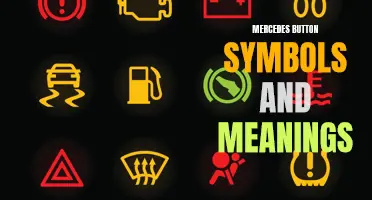
Decoding the Mercedes Button Symbols: Unveiling Their Meanings and Functions
- Jul 20, 2023
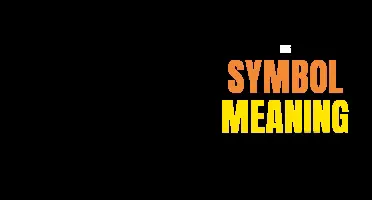
The Meaning Behind the IHS Symbol: Uncovering its Origins and Significance
- Jul 25, 2023
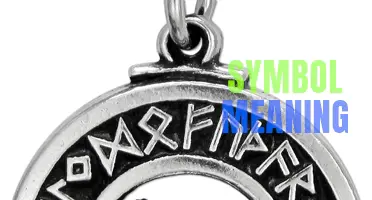
The Hidden Story Behind the Wolfsangel Symbol: Unearthing its Unique Meanings
- Jul 24, 2023
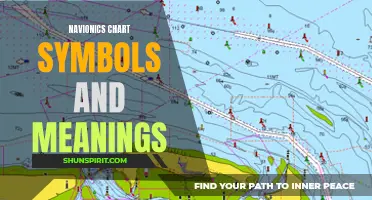
Understanding Navionics Chart Symbols and Meanings
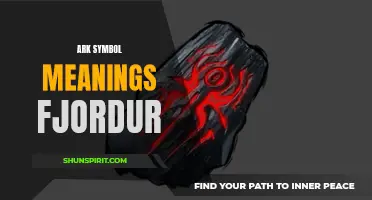
Exploring the Symbolic Meanings of the Ark in Fjordur
- Jul 22, 2023
- Forgiveness
- Resurrection
The Jewish Origin of the Vulcan Salute
By Rabbi Yonassan Gershom - May 24, 2009
The Vulcan "live long and prosper" salute is based upon a blessing gesture used by the Jewish priests (kohanim) during the worship service, and was created by Leonard Nimoy (Spock), who drew on his on childhood synagogue experiences for the inspiration.
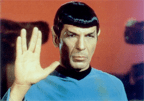
Nimoy felt that there should be some kind of distinctive greeting among Vulcans, analogous to a handshake or a bow. Alan Dean Foster's novelization, based on an early script, has Spock kneeling before the Vulcan matriarch, T'Pau, who places her hands on his shoulders, like royalty dubbing a knight. But Nimoy didn't care for this. Previous episodes had already established that Vulcans are touch telepaths. Therefore, a touch on the shoulders would be an invasion of privacy. Instead, Nimoy drew upon his own Jewish background to suggest the now-familiar salute. Back in the 1960s, hippies who watched "Amok Time" thought the salute was a variation of the two-fingered peace sign. But we Jews knew better. The Vulcan salute came not from protest marches, but from the pulpit of Nimoy's childhood synagogue.
The Vulcan greeting is based upon a blessing gesture used by the kohanim (koe-hah-NEEM) during the worship service. The kohanim are the genealogical descendants of the Jewish priests who served in the Jerusalem Temple. Modern Jews no longer have priests leading services as in ancient times, nor do we have animal sacrifices anymore. (Yes, people really do ask about that!) The sacrificial system ended with the destruction of the Temple by the Romans in the year 70 C.E. However, a remnant of the Temple service lives on in the "kohane blessing" ritual (duchenen in Yiddish) that is performed on certain holy days.
The actual blessing is done with both arms held horizontally in front, at shoulder level, with hands touching, to form the Hebrew letter "shin." This stands for the Hebrew word for "Shaddai," meaning "Almighty [God]." Nimoy modified this gesture into one hand held upright, making it more like a salute. So, technically, the Vulcan greeting is not the same thing as the ceremonial Jewish blessing. Still, the resemblance is close enough to evoke instant recognition among knowledgeable Jews.
During the synagogue service, the worshippers are not supposed to look at the kohanim while the blessing is being given. The reason for this is to focus our attention on the words of the prayer itself, rather than on the personalities of the kohanim. The kohanim are merely the channels, not the source, of the blessing, which comes from God. Unfortunately, all sorts of silly superstitions have arisen about this ritual, such as "Don't look at the kohanim, or you'll go blind!" and other nonsense. The real reason is simply to focus on receiving blessings directly from God, not from human beings.
Like most Jewish children, young Leonard Nimoy could not contain his curiosity about what the kohanim were really doing up there in front of the congregation. He writes:
"The special moment when the Kohanim blessed the assembly moved me deeply, for it possessed a great sense of magic and theatricality... I had heard that this indwelling Spirit of God was too powerful, too beautiful, too awesome for any mortal to look upon and survive, and so I obediently covered my face with my hands. But of course, I had to peek." (From his autobiography, I Am Spock.)
Nimoy survived his peeking unscathed, and saw the kohanim extending their fingers in the mystical "shin" gesture. That magical moment remained with him for life, and was there to draw upon years later when he invented the Vulcan salute.
Did Gene Roddenberry know, at the time of filming, that the Vulcan salute was based on a Jewish ritual? That question remains unanswered. My sense is that he probably didn't or he would have objected to it on the grounds of its being too "Judeo-Christian." More likely, he thought it was a weird variation of the peace sign. Certainly, that's how gentile Trekkers saw it for many years. Only much later did Nimoy publicly explain the source of his inspiration.
We should also note that the prohibition against peeking only applies during the actual blessing ritual. The gesture itself is nothing secret. You can see it openly displayed in books and on amulets, jewelry, wall decorations, and gravestones. Contrary to urban legend, Nimoy was not violating any Jewish taboos by using this gesture on "Star Trek," especially since he modified it from the original version. I, for one, think it's absolutely wonderful that something so authentically Jewish has become universally recognized as a greeting of peace. More than anything else in Trekdom, the Vulcan salute says to me, "Here there be Jews." It also provides a diplomatic way for me to greet female Trekkers at conventions without shaking hands. (Orthodox Jews do not shake hands with the opposite sex. I suppose that would also hold true for intersexed alien species.)

- Library of World Religions
- Advertise With Us
- Write for Us
- Privacy Policy
- Terms of Service
- Do Not Sell My Data
- Radiant Digital
- Manage Newsletter Subscriptions
- Unsubscribe From Notifications

- Hugh Nibley mp3
- Books/Articles Online
- Nibley Video
- Nibley Quotes, Stories
- Hugh Nibley Notes
- Book of Mormon Manuscript original
- Book of Mormon Reader, original
- Book of Mormon, the earliest text, ed. Royal Skousen
- The Bible Project (videos)
- Calendars (Solar, Lunar, Seasons, Jewish)
- Dictionaries
- First Grade
- Second Grade
- Third Grade
- Fourth Grade
- Fifth Grade
- Sixth Grade
- Grades 7 – 8
- Grades 9 – 12
- Lesson Plans for homeschool
- Crafts for Kids
- Why homeschool
- How to homeschool
- Lotions & Potions
- Herbs & Health
- Cooking & Baking
- Survival & Prepping
- Men and Women
- Blast from the Past
- Family History
- Little Rascals
Select Page
Where did Spock get his Vulcan hand sign?
Jun 12, 2020
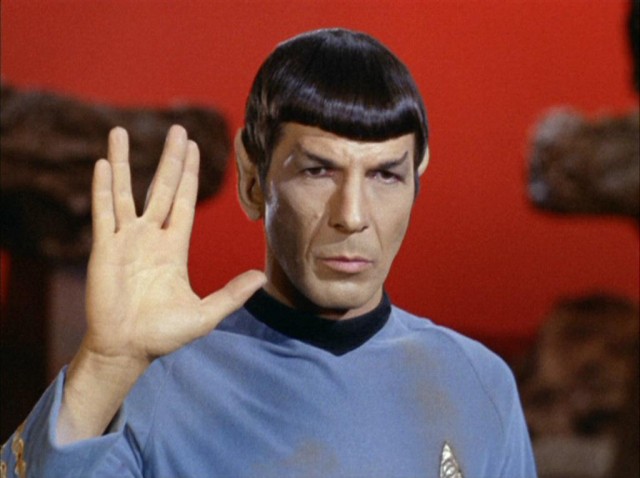
At a young age, Leonard Nimoy saw a sign that later became his trademark and Vulcan salute of “live long and prosper.” I had read that this hand gesture was based on the compass and the square. But there’s more.
After some research, I discovered that the Vulcan sign used by Mr. Spock had a priestly background. Leonard Nimoy, who played Spock in the epic series, Star Trek, shared the history behind his famous hand sign. At about 8, Nimoy attended synagogue during the High Holy Days with his parents (Jewish immigrants from Ukraine). While there, he saw the blessing called Birkat Kohanim, performed by the priestly descendants of Aaron — the Kohens or Cohens.
“A group of men at this particular synagogue, the Kohen, members of a priestly tribe, stood up in front of the congregation to bless everyone,” Nimoy remembered. “They were very loud, ecstatic, almost like at a revival meeting, and they were shouting this prayer in Hebrew, ‘May the Lord bless and keep you…’ but I have no idea at the time what they’re saying. My father said ‘Don’t look’ and everybody’s got their heads covered with their prayer shawls or their hands over their eyes. And I see these guys with their heads covered with their shawls but out from underneath they have their hands up. It was chilling, spooky and cool.” Their hands, of course, were stretched out in the gesture that would be the Vulcan salute. “It’s the shape of the letter Shin in Hebrew, which is the first letter in the word Shaddai , a word for God, and shalom , the word for peace. It came back to me years later when we made a “Star Trek” episode “ Amok Time” when Spock returns to his home planet for the first time and we see him interact with Vulcans.” (Los Angeles Times)
The hand sign forms the Hebrew letter Shin, representing God or fire. So, according to tradition, not the compass and the square, but an interesting sign, because if you look closely at when Spock makes the hand gesture, it does form a compass and square (if the thumb is fully extended and depending on how limber your joints are.) In the traditional priestly blessing upon which this was based, it appears that sometimes the fingers form five spaces to create a lattice, and other times the fingers are not divided, or the thumbs form a triangle.

The Priestly Blessing ifound in Numbers 6:24-26 was used by Aaron and his sons for blessing the children of Israel. You might say that this blessing on the people in a congregation is similar to the benediction, or closing prayer in many Christian denominations.
The Priestly Blessing, Birkat Kohanim, is also known as Nesi’at Kapayim, or the “lifting of the hands,” because the priests’ lift their hands, through which the divine blessings flow.
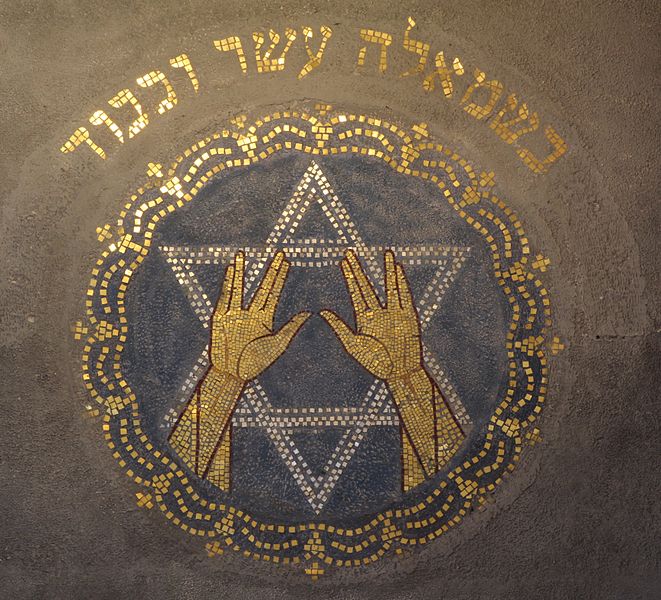
The Kohanim (priests and descendants of Aaron) reach forward with their arms, holding their hands together, thumbs touching, palms-down with their fingers separated, so there are five spaces: One space between the thumbs, a space between the thumb and first finger of each hand, and a space between the second and third finger of each hand. After the Kohanim assemble on the platform, the cantor or prayer leader will prompt them by reciting each word of the blessing, and the Kohanim will repeat that word.
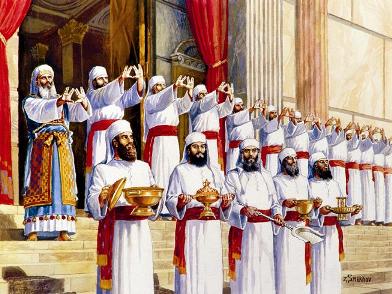
And the Lord spake unto Moses, saying, Speak unto Aaron and unto his sons, saying, On this wise ye shall bless the children of Israel, saying unto them,
The Lord bless thee, and keep thee:
The Lord make his face shine upon thee, and be gracious unto thee:
The Lord lift up his countenance upon thee and give thee peace.
And they shall put my name upon the children of Israel, and I will bless them. (Numbers 6:22-27)

- Privacy Overview
- Strictly Necessary Cookies
This website uses cookies so that we can provide you with the best user experience possible. Cookie information is stored in your browser and performs functions such as recognising you when you return to our website and helping our team to understand which sections of the website you find most interesting and useful.
Strictly Necessary Cookie should be enabled at all times so that we can save your preferences for cookie settings.
If you disable this cookie, we will not be able to save your preferences. This means that every time you visit this website you will need to enable or disable cookies again.
Give Me a Sign: The Stories Behind 5 Hand Gestures
By rob lammle | jan 19, 2023, 10:28 am est.

So much can be said with a hand gesture. Here are the stories behind gestures you might use every day, and some you might not.
Table Of Contents
1. the vulcan salute, 2. the shaka sign, 3. the corna, 4. the pledge of allegiance, 5. the high five.
We all know it, even if we can't all do it. The Vulcan Salute, made famous by Leonard Nimoy as Mr. Spock on the original Star Trek , has become a cultural icon recognized even by those who have never been to a sci-fi convention. And while the gesture is meant to be from another planet, its inspiration is anything but alien.
When Nimoy was a child, he witnessed a Jewish ritual called the "kohane blessing," which uses a hand sign meant to resemble the Hebrew letter "shin," which symbolizes the Hebrew word for "Shaddai," meaning "Almighty (God)." (Got that?) It's made by splitting the hand down the middle—holding the index and middle fingers together, the ring and pinky fingers together—and then the thumb pressed firmly against the side of the hand. The Orthodox priest giving the blessing holds both hands out in front of him in these strange configurations, palms down. When Nimoy was developing a greeting to be used between Vulcans, he remembered the sign and adapted it, using only one hand held up, and pulling his thumb away from the rest of the hand.
Nimoy had no problem doing the salute, but not all Trek actors have been so lucky.
William Shatner had to have his fingers tied together with fishing line whenever Captain Kirk needed to use the sign. Even the latest pointy-eared Vulcan, actor Zachary Quinto, who played a younger Mr. Spock in the recent blockbuster film, had to have his fingers stuck together with the skin-safe superglue used by hospitals as a replacement for traditional stitches.
The oldest origin story goes back to the days when Spanish sailors first landed on the Hawaiian Islands. Unable to speak the native tongue, but trying to be friendly, the Spaniards offered to share a drink by mimicking a bottle with their hand with the gesture and tilting back their head. This became such a common greeting that the natives simply believed that's how the Spanish said hello, so they started using the sign whenever the two groups encountered one another.
Another theory, from the mid-20th Century, claims the sign was inspired by the wave of a beloved local named Hamana Kalili, who'd lost the middle fingers on one hand. There are multiple theories as to how he lost his fingers: there was a shark attack, they were blown off while using dynamite to catch fish, or perhaps the digits were lost in an accident while working on a sugar plantation. But no one knows for sure anymore.
As if the origin of the gesture isn't mysterious enough, the word Shaka isn't even Hawaiian. However, most people agree the name goes back to a local used car salesman, Lippy Espinda, who would throw up the sign at the end of popular TV commercials during the 1960s and 70s, and say, "Shacka, brah!" ("Shocker, bro!")
During his Inauguration Parade, Barack Obama threw the Shaka Sign to greet Honolulu's Punahou School marching band.
If you're in Italy or Spain and you flash this sign towards a man, you might get beaten up. In this culture, the symbol represents the horns of one of nature's most virile animals, the bull. The bull in this case is usually meant to symbolize the guy sleeping with the man's wife behind his back. The sign can also be interpreted with the cuckold as the bull, who has been symbolically castrated by his wife. Either way it's bound to make him see red.
However, turn your palm down and point the extended fingers at someone who doesn't like you, and you're simply guarding yourself from the Evil Eye. In ancient times, bulls were often seen as protective deities, so turning the bull's horns against an enemy was a way of keeping the curse at bay.
On a similar note, in South America, if you have the horn sign held up and twist it back and forth, it's known as "lagarto" or Lizard Gesture. Similar to the old superstition "Knock on wood," it's thought that by doing this you can protect yourself from any bad mojo that might occur after someone utters the taboo word "culebra," or snake.
Of course the corna is also used by fans of the University of Texas, where they call it the "Hook 'Em Horns." Created in 1955 by student Harley Clark, the sign represents the school's mascot, a Texas longhorn steer named Bevo, and his impressive 72" horns. Being a
Texas native
former Governor of Texas, though not a UT alumni, President George W. Bush and his family were known for flashing the Hook 'Em Horns during appearances in the Lone Star State.
But there's another group of fans who use the corna, too "“ fans of heavy metal music. The gesture in metal goes back to occultist band Coven, a group heavily inspired by counter culture figures like renowned Satanist Anton LaVey, who used the corna as a sign of the Devil. However, it was Ronnie James Dio, lead singer for Black Sabbath in the late-1970s, that really made the sign take hold in the genre. He borrowed the gesture from his superstitious Italian grandmother who used it to ward off evil. He felt the sign's pagan origins fit perfectly with the subject matter of the band's music.
Chances are, when you were saying the Pledge of Allegiance in elementary school, you placed your hand over your heart in a sign of adoration for Old Glory. But if you were in school before World War II, you probably used an entirely different gesture to address the flag—the Bellamy Salute.
However, as the years went by, parts of the Bellamy Salute fell out of use, while others evolved. First, the military salute was abandoned, leaving only the straight arm presentation of the flag. But then the palm went from facing up, to sideways, and by the 1940s, it faced down. This last version became a problem as America entered World War II, because it so closely resembled the stiff-armed salute of dictators Mussolini and Hitler. The hand over the heart gesture was suggested as a viable alternative and President Franklin Roosevelt signed it into law in 1942 as part of the Flag Code, making it the official gesture for the Pledge of Allegiance we all know today.
While no one can say for sure where the high five came from, some believe the first one was exchanged between Glenn Burke and Dusty Baker, baseball players for the L.A. Dodgers, after a home run in 1977. But there is one man who claims he knows the origin of the high five, because he says he's the guy who invented it.
Lamont Sleets, Jr. says he adopted the high five from a salute his father exchanged with old Army buddies from the 5th Infantry regiment, nicknamed "The Five." To say hello, the men would stick their hand straight up in the air, spread their fingers wide, and call out "Five!" Anytime he saw the Five greeting, Sleets Jr. would say "Hi, Five!" to the visiting veteran and slapped the upraised hand with his own. Sleets Jr. went on to become one of the top basketball players at Murray State University in the late-1970s and he brought his odd salutation with him. It became popular with his teammates, and as the team traveled the country to play other schools, Sleets says the gesture caught on.
To celebrate this infamous hand gesture, students at the University of Virginia created "National High Five Day," which takes place on the third Thursday in April (yesterday). * * * * * * Have a favorite fun hand gesture we didn't mention? Is there one you've always wondered where it came from? Tell us about it in the comments below!

The Hebrew Origins of the Vulcan Hand Sign of Spock
by Moe | Jun 10, 2015 | History of the Brotherhood , Meaning of Symbols | 1 comment
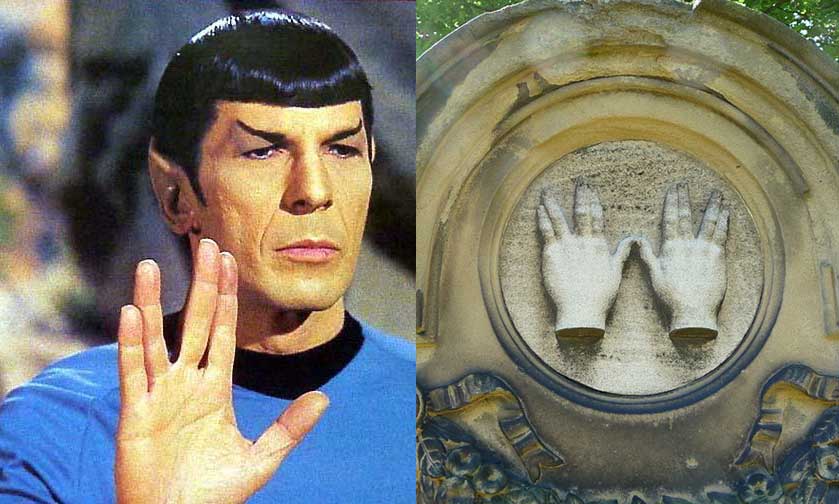
The priests perform what is called the nesiat kapayim or the “ Priestly Blessing ”, that accompanies the prayer service. The Levites use two hands with the thumbs touching and fingers paired and split, and extended outward for the Shin gesture forming the letter Shin (שׁ), an emblem for Shaddai, “Almighty [God]” which can be seen in the images above and below.
This ancient hand sign of the Levites was made famous in modern times during the 1960’s-70’s when the TV cult classic called StarTrek with one of the lead Jewish actors, Leonard Nimoy who played the pointed ear half human and half Vulcan named Spock .
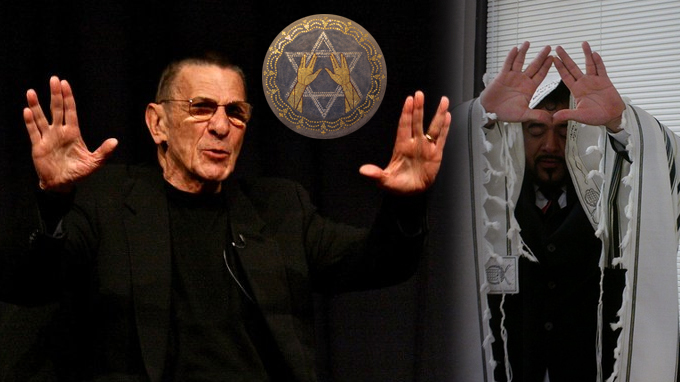
This mixed breed Vulcan character is interesting given the fact that in the Hebrew Torah and Book of Enoch we learn about a mysterious group of half-breed humans who are sometimes called the Sons of God, and the Nephilim who had mated with the daughters of men. Spock was also from an alien type father who was a Vulcan and his mother was human.
It was the character of Spock introduced the Hebrew sign for the letter Shin (שׁ), an emblem for Shaddai, “Almighty [God]” as the salutary Vulcan hand signal used for greeting others. In addition, Spock was a scientist who worked with healers and the Kohanim Levites were known in ancient times not only as priests, but as the world’s first scientists and doctors who were healers that travelled the world working and healing at various King’s courts around the world. One of the most famous Kohanim Levites is actually the Father of Medicine, Hippocrates.
Also, let us not forget that the Star Trek theme with Spock was based on the people known as the Vulcans losing their homeland in the 2009 movie and forced to wander in space on USS Enterprise much like the Jews were expelled from their ancient homeland and forced to wander to this very day.
I thought that it was pretty cool that later in his life, Nimoy had given several interviews where he explained his Jewish heritage and how the Hebrew origins of the Vulcan hand signal. He first saw what became the famous Vulcan salute , “live long and prosper,” as a child at an Orthodox Jewish synagogue service in Boston. In a 2013 interview, he had said, “This is the shape of the letter shin,” making the famous V gesture.
The Hebrew letter shin, he noted, is the first letter in several Hebrew words, including Shaddai (a name for God), Shalom (the word for hello, goodbye and peace) and Shekhinah, which he defined as the feminine aspect of God who supposedly was created to live among humans.
The Shekhinah, Nimoy has said, was also the name of the prayer he participated in as a boy that inspired the salute. The prayer, meant to bless the congregation, is named after the feminine aspect of God, Nimoy explained in a 2012 post on the Star Trek site.
He was born in Boston, but his parents came from a village in what is now Ukraine, where his father worked as a barber. “My first language was English,” Nimoy told the interviewer in Yiddish, “but I needed to speak Yiddish with my grandparents.”

Moe is the founder of GnosticWarrior.com. He is a father, husband, author, martial arts black belt, and an expert in Gnosticism, the occult, and esotericism.
Related Posts:
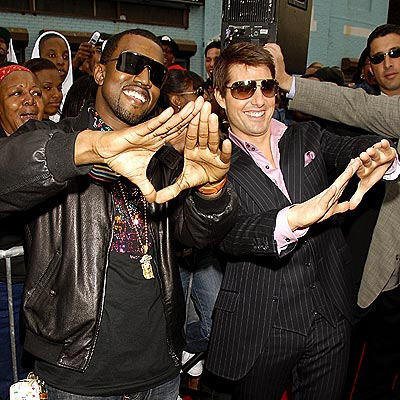
shadai is an acronym for shomer delet yisrael – guardian of the gates of israel, and the letter shin or the acronym appear on a mezuzah door talisman box containing a parchment with the ten commandments
Submit a Comment Cancel reply
Your email address will not be published. Required fields are marked *
Most Popular Media
- The Gnostic God Yaldabaoth 292 views
- The Third Eye 269 views
- Seal of Solomon 246 views
- The Science of 666 228 views
- The Meaning of the Circumpunct 218 views
- The Hidden Templar Symbology of the OREO Cookie 169 views
- Abraxas 167 views
- Phillip K. Dick: The Black Iron Prison of the Empire that Never Ended 158 views
- The 8 Pointed Star of the Anunnaki 140 views
- The Kalash People: The Lost Blonde Hair and Blue Eye Tribe of Alexander the Great in Pakistan 137 views
Subscribe to the Gnostic Warrior Podcast
Pin it on pinterest.
The Star Dispatch
Star Trek News From All Timelines
Did You Know Spock’s Iconic Hand Sign in ‘Star Trek’ Actually Has New England Roots?
Actor, Leonard Nimoy who plays Spock, actually grew up in Boston. It was Nimoy that brought this hand gesture to Star Trek. According to StarTrek.com …Google Alert – "Star Trek" Read More
Screen Rant
Mirror universe spock’s fate in star trek: discovery explained.
Star Trek: Discovery filled in some of the gaps in Mirror Universe history and revealed the fate of Spock after Star Trek: TOS" "Mirror, Mirror."
Warning: SPOILERS for Star Trek: Discovery Season 5, Episode 5 - "Mirrors"
- Mirror Universe Spock's death led to a revolution in the Terran Empire, but ultimately couldn't prevent its downfall.
- The ISS Enterprise became a symbol of hope in the Mirror Universe, with rebels seeking freedom in the Prime Universe.
- Dr. Cho, a refugee from the Mirror Universe, rose to become a Branch Admiral in Starfleet, shaping her own future.
Star Trek: Discovery confirmed the fate of Mirror Universe Spock (Leonard Nimoy) after the events of the classic Star Trek: The Original Series episode, "Mirror, Mirror." Since its first appearance on TOS, several Star Trek series have visited the Mirror Universe, a parallel universe populated by evil versions of Star Trek's heroes. In the Mirror Universe, the xenophobic Terran Empire serves as the antithesis to the United Federation of Planets, and torture and murder are commonplace. Captain Michael Burnham (Sonequa Martin-Green) and the USS Discovery are already familiar with the Mirror Universe, as they spent some time there in Discovery season 1.
In Star Trek: Discovery season 5, episode 5 , "Mirrors," Captain Burnham and Cleveland Booker (David Ajala) follow couriers Moll (Eve Harlow) and L'ak (Elias Toufexis) into interdimensional space in search of the next clue leading to the Progenitors' treasure. Once there, they find the damaged ISS Enterprise, which holds clues about the fate of Mirror Universe Spock and his crew. In Star Trek: The Original Series season 2, episode 4, "Mirror, Mirror," Captain James T. Kirk (William Shatner) encourages Mirror Spock to initiate change, telling him: "In every revolution, there's one man with a vision." Written by Johanna Lee and Carlos Cisco, and directed by Jen McGowan, Star Trek: Discovery's "Mirrors" offers more insight into what became of that revolution.
What Happened To Mirror Universe Captain Kirk In Star Trek?
What happened to mirror universe spock revealed by star trek: discovery, spock died fighting for change..
After the events of Star Trek: The Original Series' "Mirror, Mirror," Captain Kirk left Mirror Universe Spock with a lot to think about. The goateed Vulcan apparently took Kirk's words to heart and began enacting a series of reforms to change the way things were done in the Terran Empire. Although he was attempting to prevent the collapse of the Empire, Star Trek: Discovery revealed that Spock was killed while working on his reforms. In Star Trek: Discovery season 5, episode 5, Burnham and Book explore the ISS Enterprise and discover a plaque detailing some events from the Mirror Universe.
“The light of hope shines through even the darkest of nights" became a "rallying cry" for those who opposed the violence of the Terran Empire.
Reading from the plaque, Book says that the "Terran High Chancellor was killed for trying to make reforms." Although Michael does not know that Spock was the Terran High Chancellor, the audience knows this information in Star Trek: Deep Space Nine's Mirror Universe episodes. Spock helped turn the Terran Empire into a more peaceful galactic power, and while his reforms were popular with many, some clearly opposed them. Nevertheless, Spock's dedication to logic made him less villainous than his Mirror Universe counterparts, and his words: “The light of hope shines through even the darkest of nights" became a "rallying cry" for those who opposed the violence of the Terran Empire.
Star Trek: DS9 Reveals What Happened To Mirror Universe After Spock’s Death
Spock initiated change, but couldn't prevent the fall of the terran empire..
In Star Trek: Deep Space Nine season 2, episode 23, "Crossover," Major Kira Nerys (Nana Visitor) and Dr. Julian Bashir (Alexander Siddig) find themselves in the Mirror Universe. Major Kira's Mirror Universe counterpart, Intendant Kira, runs the equivalent of Deep Space Nine (Terok Nor) as a mining station populated by Terran slaves. The Intendant reveals that Captain Kirk's visit to the Mirror Universe had a "profound influence" on Mirror Universe Spock, which led Spock to reform the Terran Empire. Unfortunately, these reforms rendered the Empire unable to defend itself when the Klingon/Cardassian Alliance decided to attack.
After conquering the Terran Empire, the Alliance proved to be just as brutal and eventually became ruled by Regent Worf (Michael Dorn).
Having been under Terran occupation for years, Bajor petitioned for entry into the Klingon/Cardassian Alliance and went on to become a major player in the Alliance. Much like Kirk's visit to the Mirror Universe affected Spock, Major Kira and Dr. Bashir's visit inspired a rebellion among the Terran slaves, which became a thorn in the side of the Alliance. Although Spock had initially been trying to prevent the fall of the Terran Empire, the Empire fell away, but some people held on to the ideals Spock had tried to spread.
Star Trek 10’s Best Mirror Universe Variants
Star trek: discovery reveals what happened to mirror universe spock’s iss enterprise, the iss enterprise became a symbol of hope and freedom..
The plaque Captain Burnham and Cleveland Booker find on the Mirror Universe's ISS Enterprise also reveals some events after Mirror Spock's death. After Spock was killed, those who believed in his reforms sought help from a "Kelpian slave turned rebel leader," aka, the Mirror Universe version of Saru (Doug Jones). Saru told these people about Star Tre k's Prime Universe, describing it as "a near perfect mirror that casts our darkness into light." While Saru stayed behind to help more people in the Mirror Universe, several rebels stole the ISS Enterprise and traveled to the Prime Universe to begin new lives.
Dr. Cho was also one of the six scientists who helped hide clues to the Progenitors' technology.
Upon returning to the USS Discovery, Michael finds proof in Federation databases that many of the refugees on the ISS Enterprise successfully made new lives for themselves in the Prime Universe . One refugee, named the Enterprise's Science Officer, Dr. Cho, joined Starfleet and eventually became a Branch Admiral. Dr. Cho was also one of the six scientists who helped hide clues to the Progenitors' technology, which remains at the center of Star Trek: Discovery season 5's quest. Michael remarks that Cho may have chosen to leave her clue on the Enterprise as a reminder that almost anyone can shape their own future, even when facing impossible odds.
New episodes of Star Trek: Discovery stream Thursdays on Paramount+.
Star Trek: Discovery
Star trek: the original series, star trek: deep space nine.

FlickSphere
21 Things About Star Trek That Fans Hesitate to Acknowledge
Posted: April 27, 2024 | Last updated: April 27, 2024
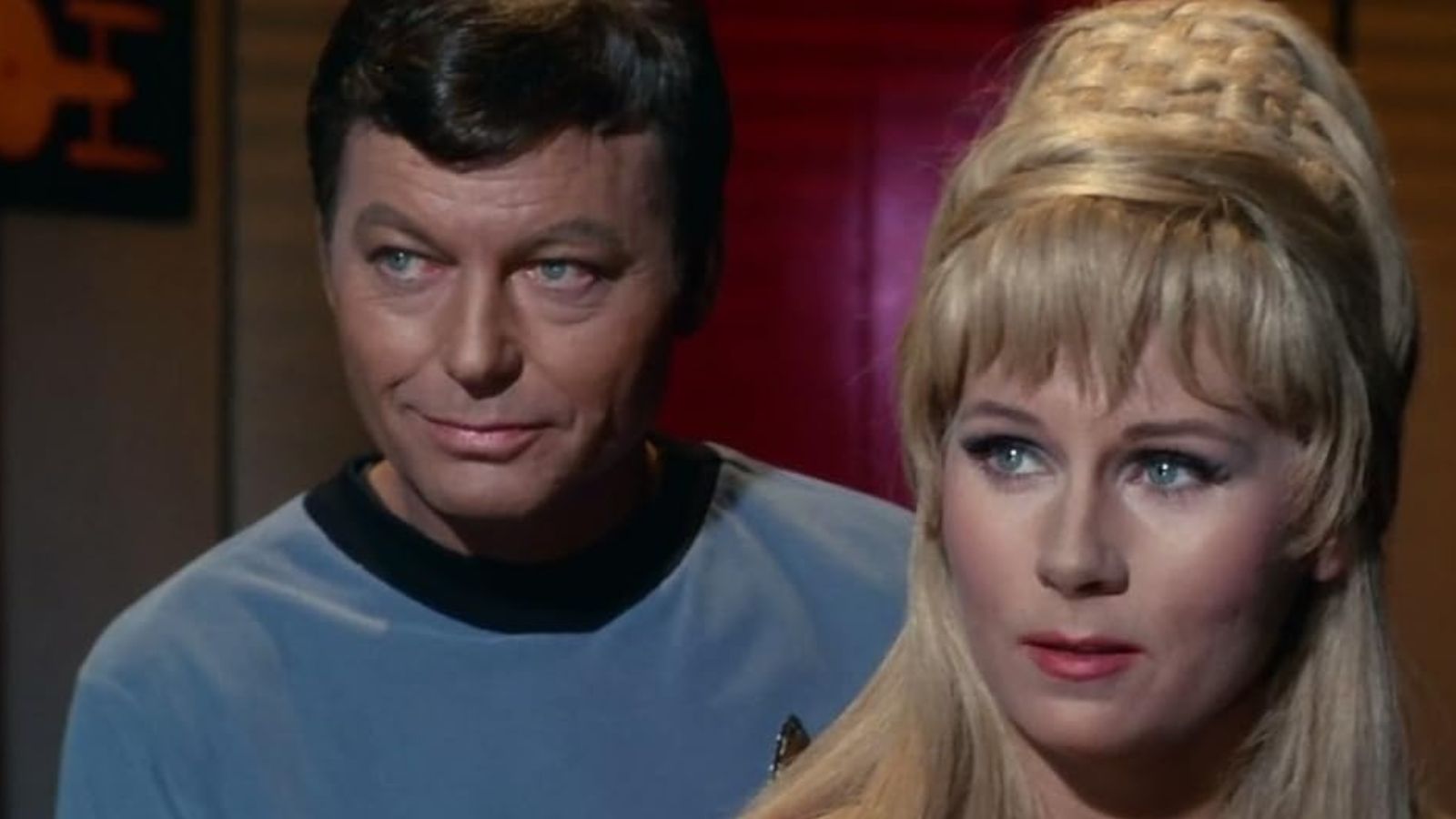
Star Trek Reused the Same Sets Often
There were some sexist vibes.
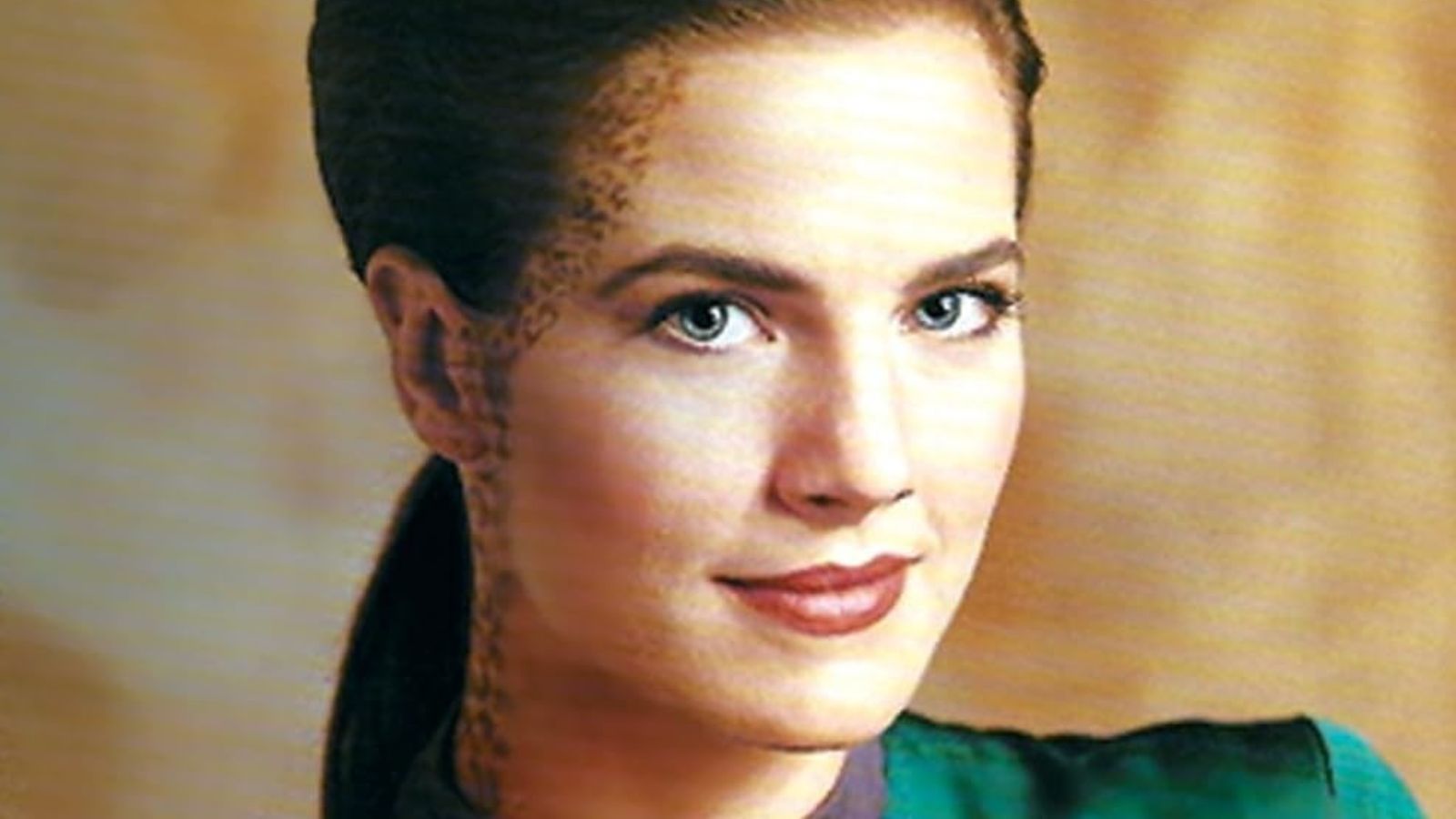
Star Trek Was Forced to Move With the Times
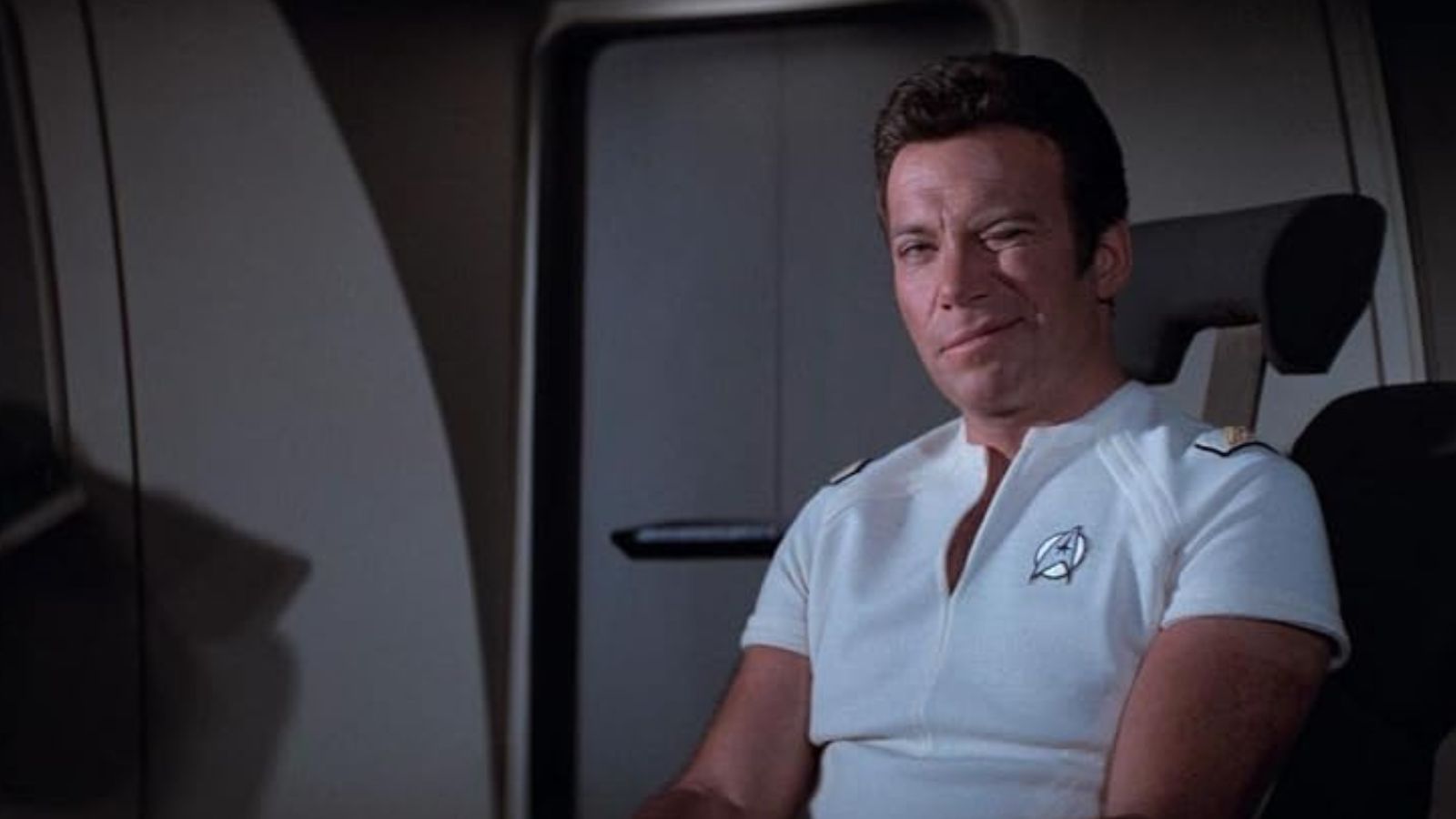
We’ve All Fancied an Alien on Star Trek at Some Point in Our Lives
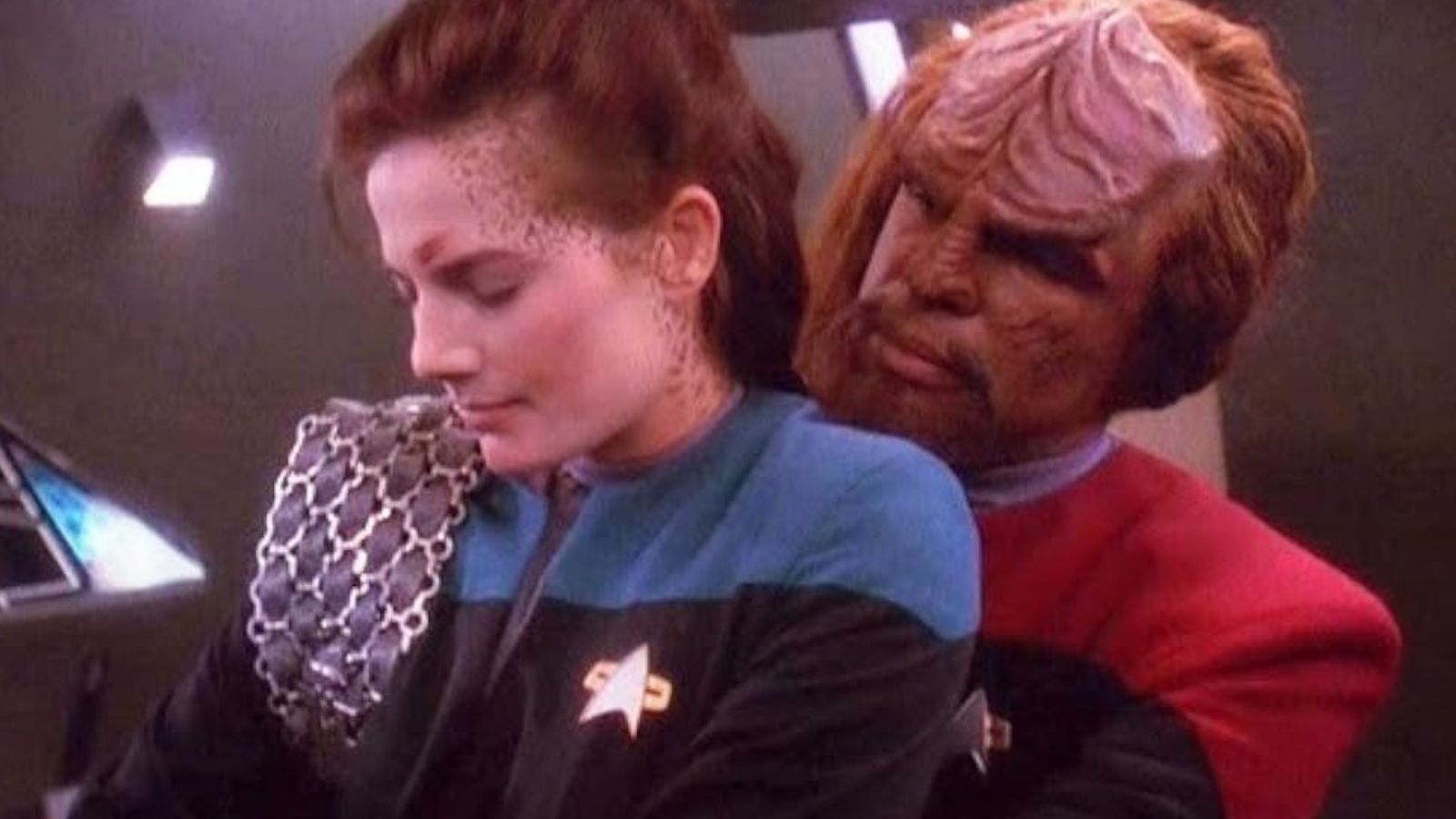
Drama in Deep Space Nine’

Star Trek Voyager Criticized for Having a Female Captain
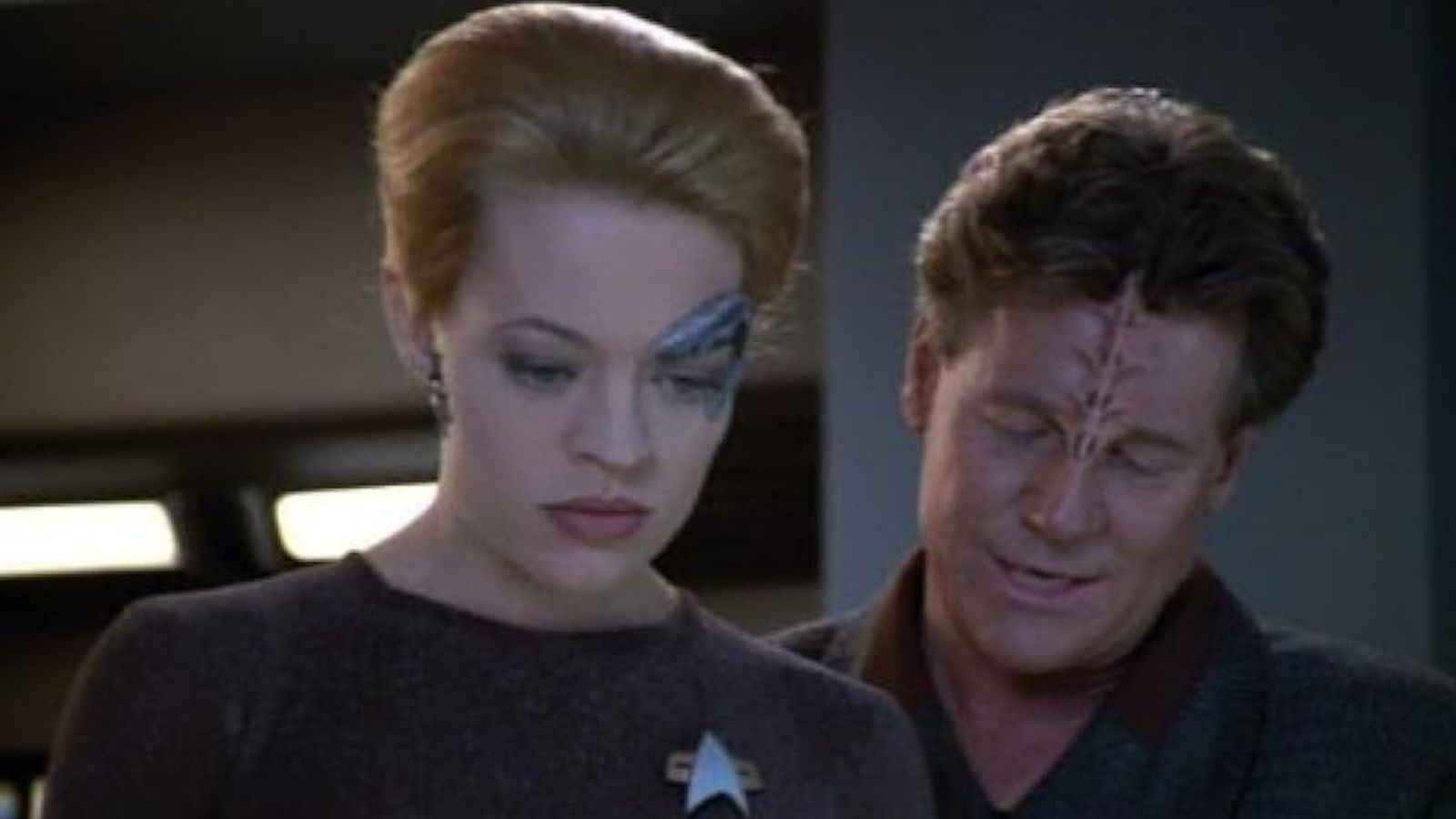
The Story Lines Weren’t Always Great
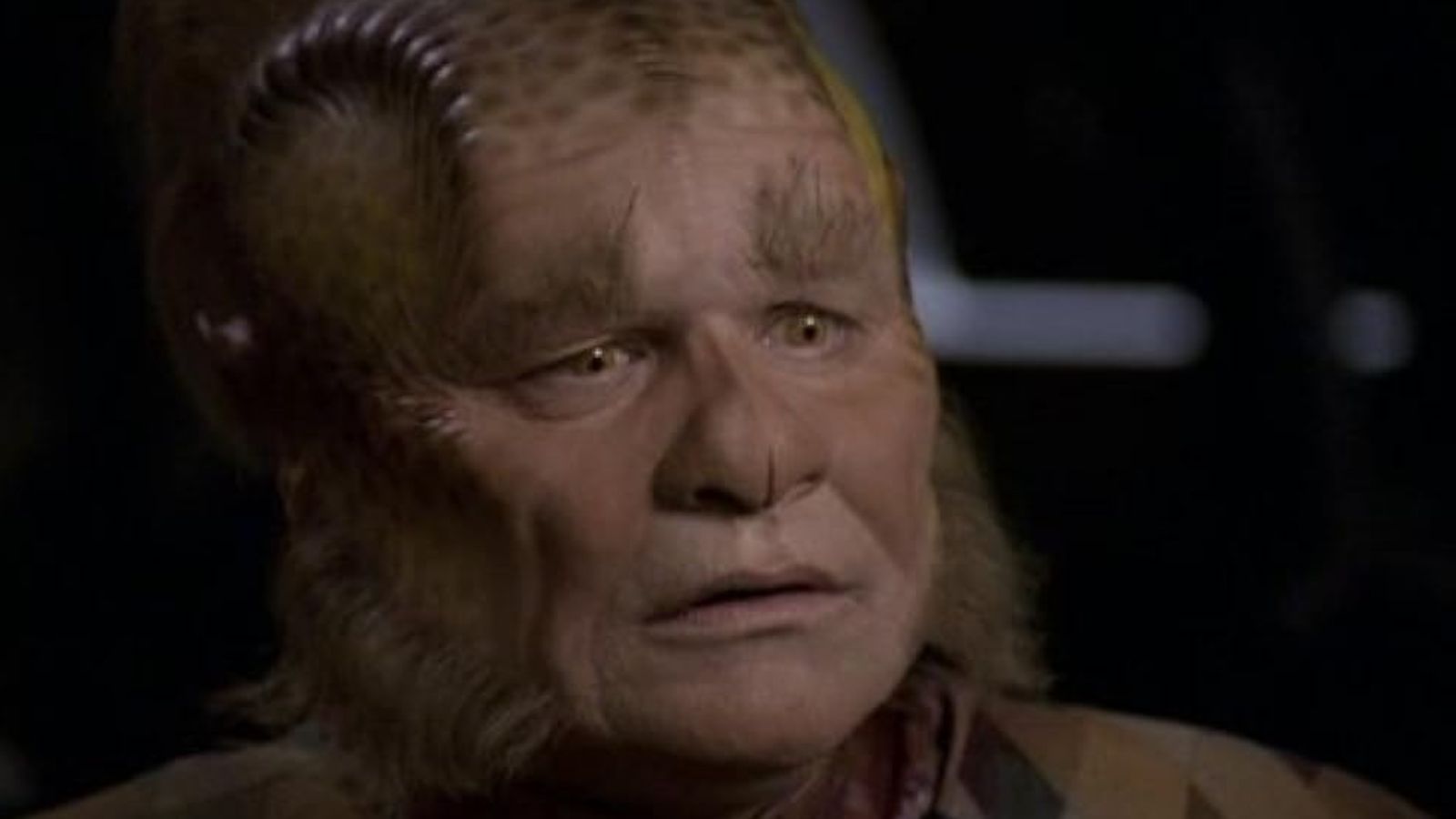
Some of the Costumes Were Not Good
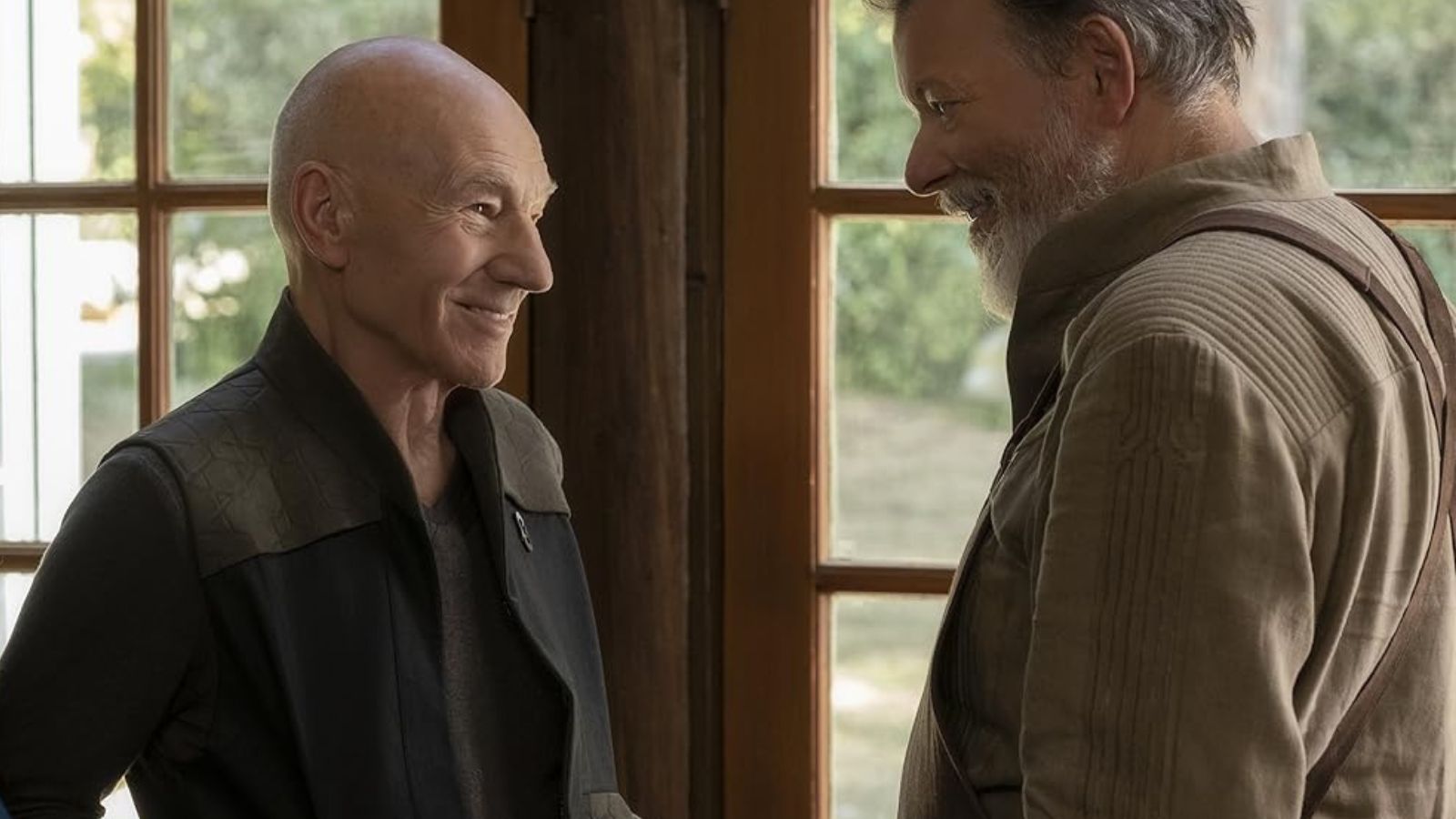
We Want Captain Picard Back
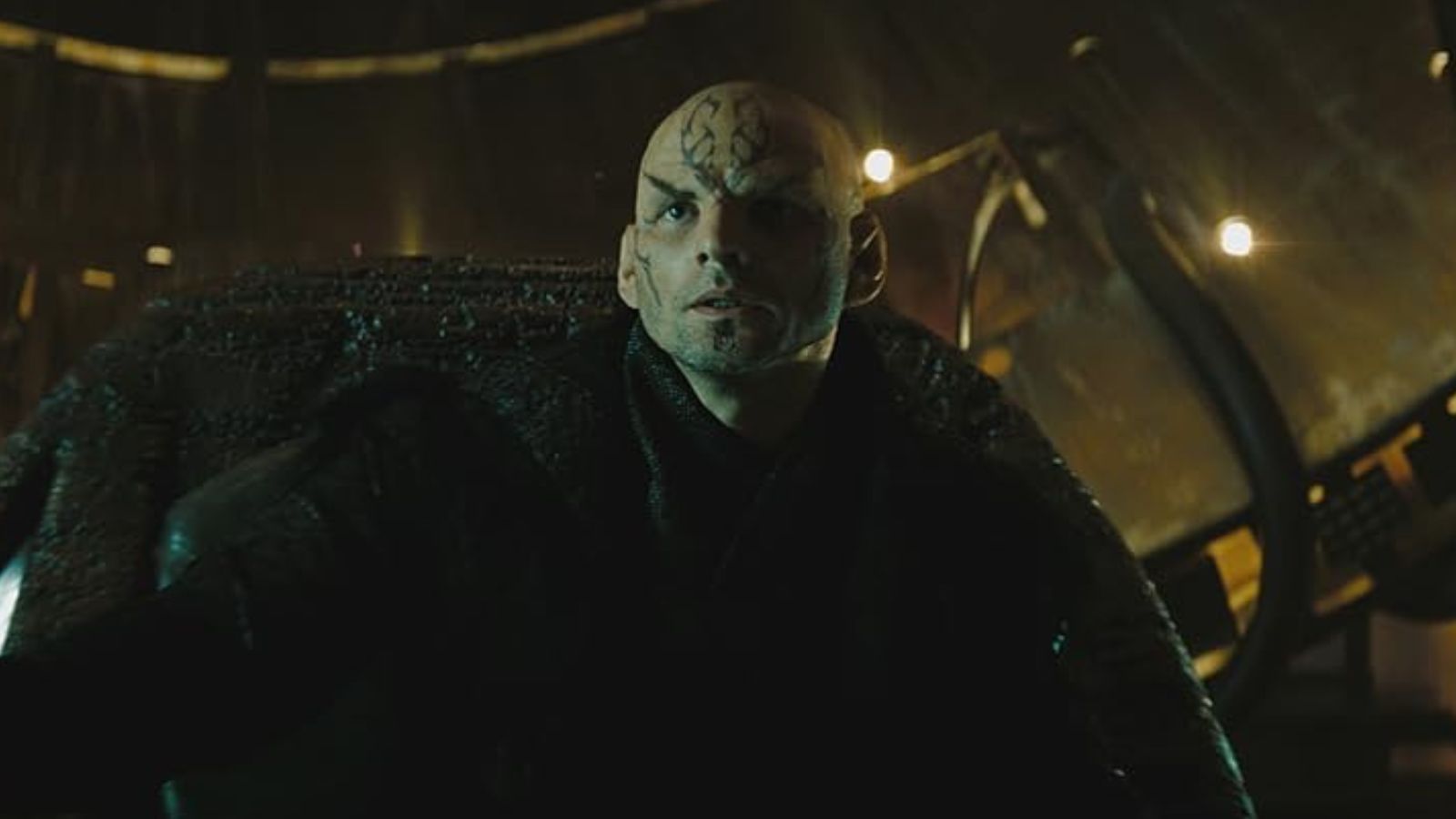
Most Fans Preferred the TV Series to the Movies
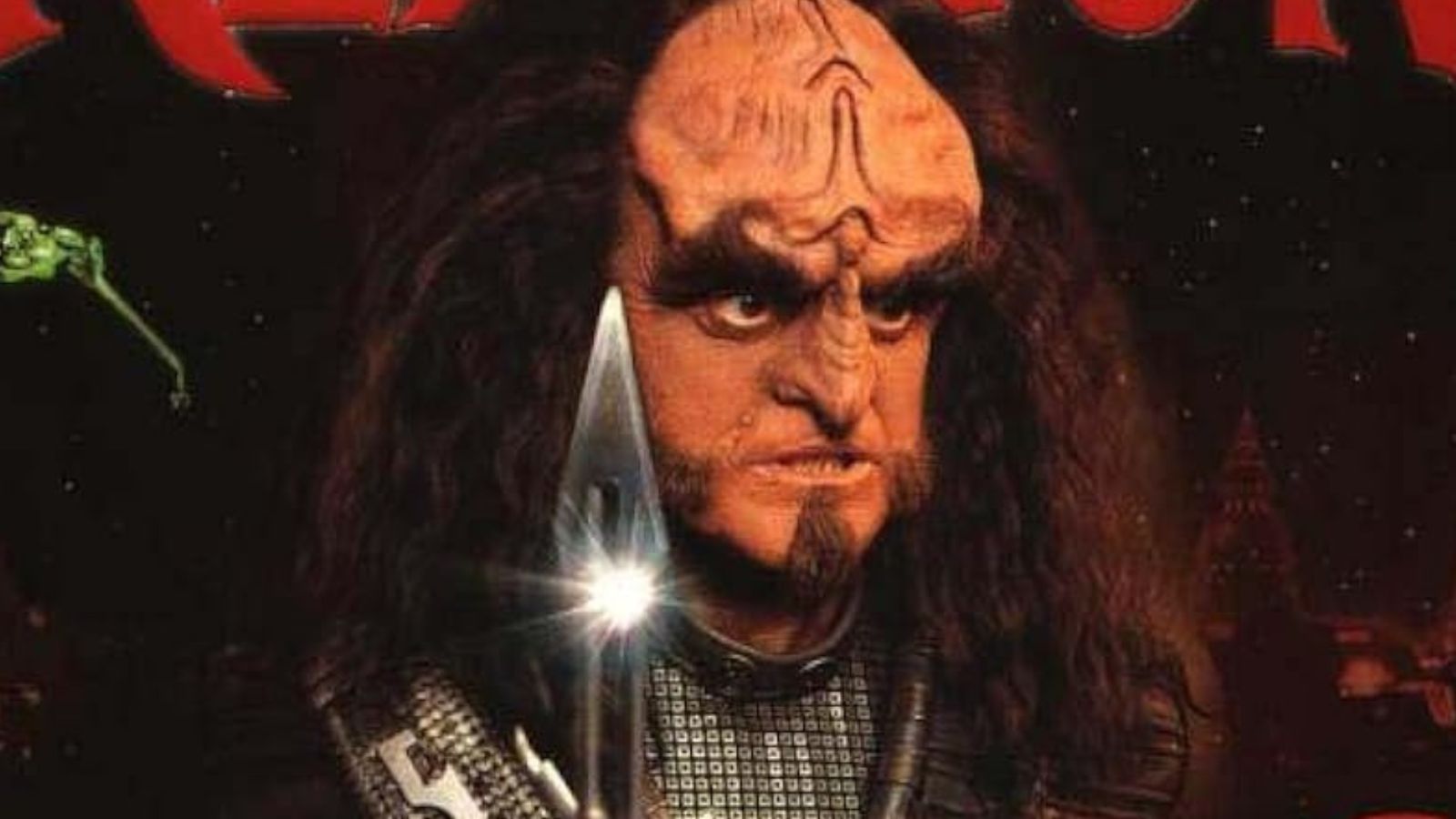
We Have all Tried to Speak Klingon
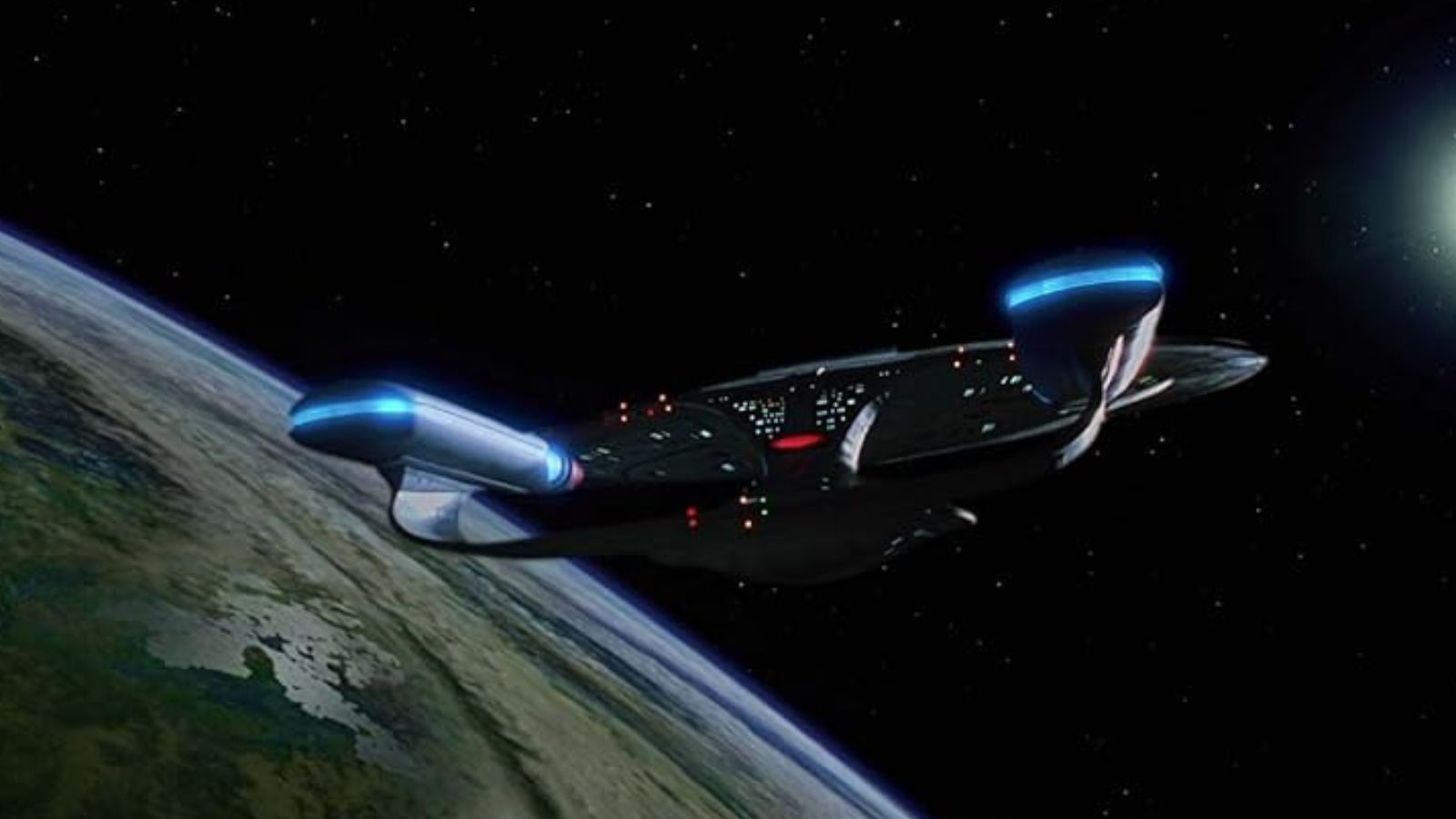
Sometimes, Star Trek Was Scary
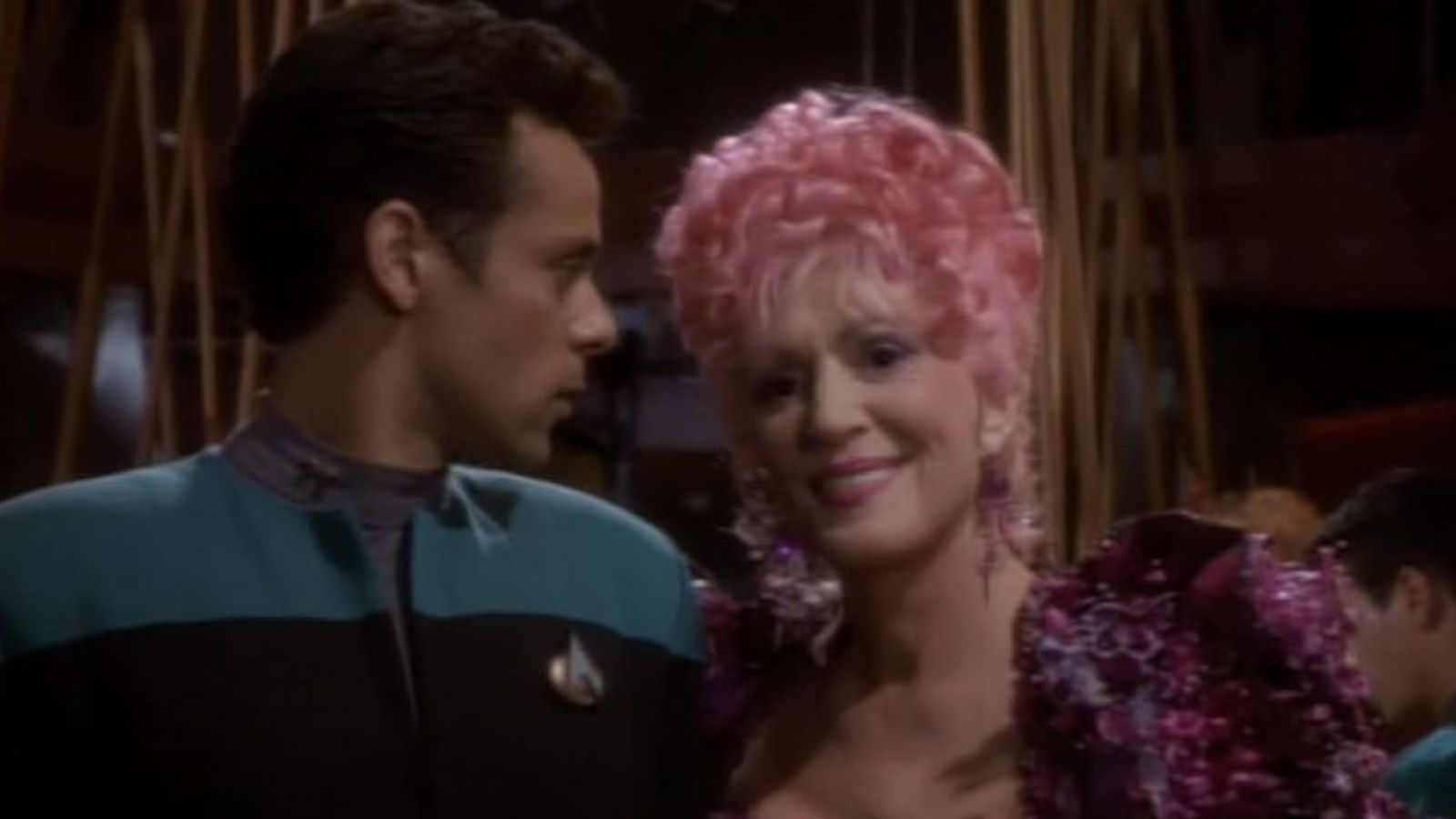
The Theme Tune Was Awesome
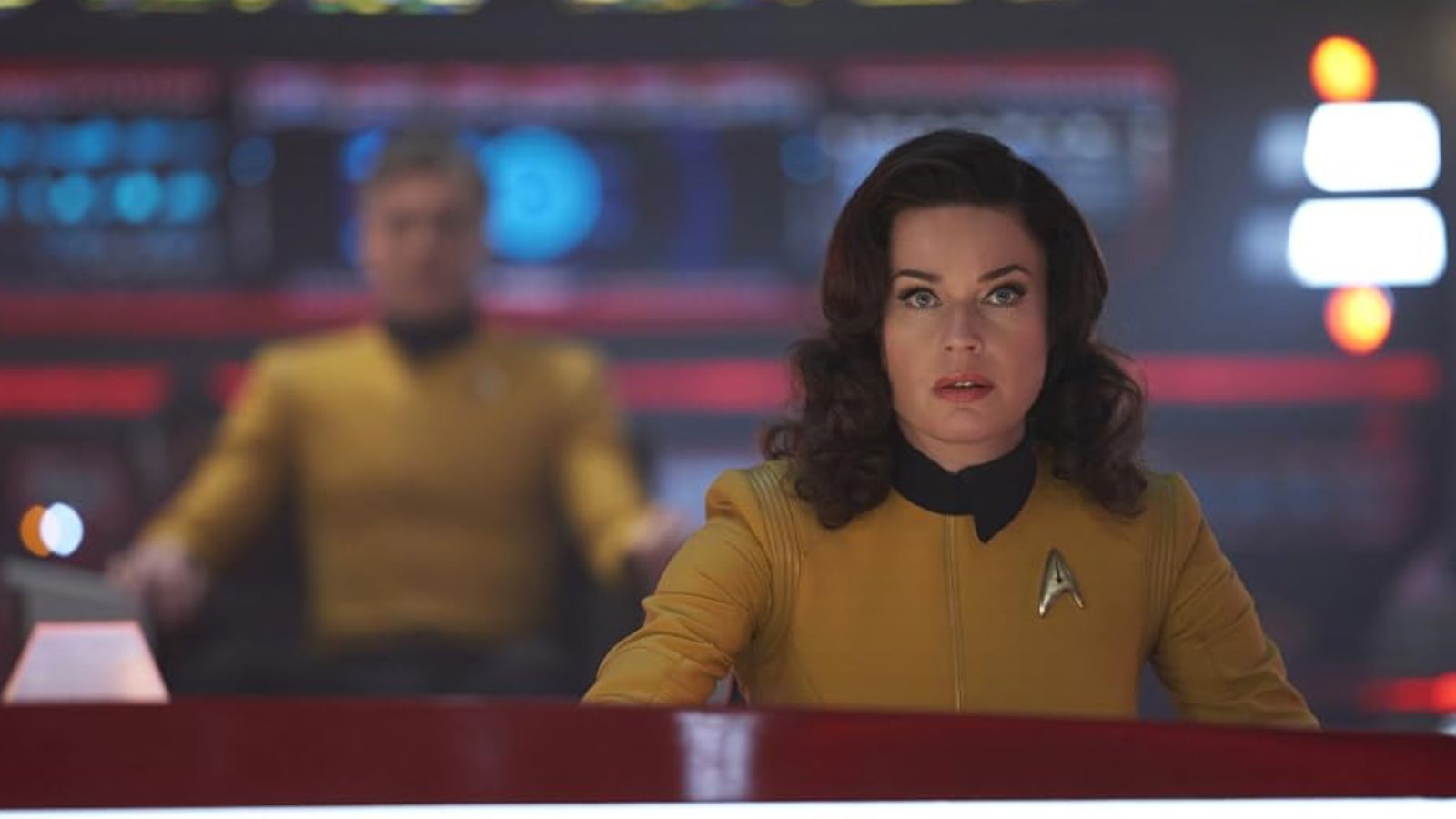
Star Trek’s Original First Officer Was a Woman
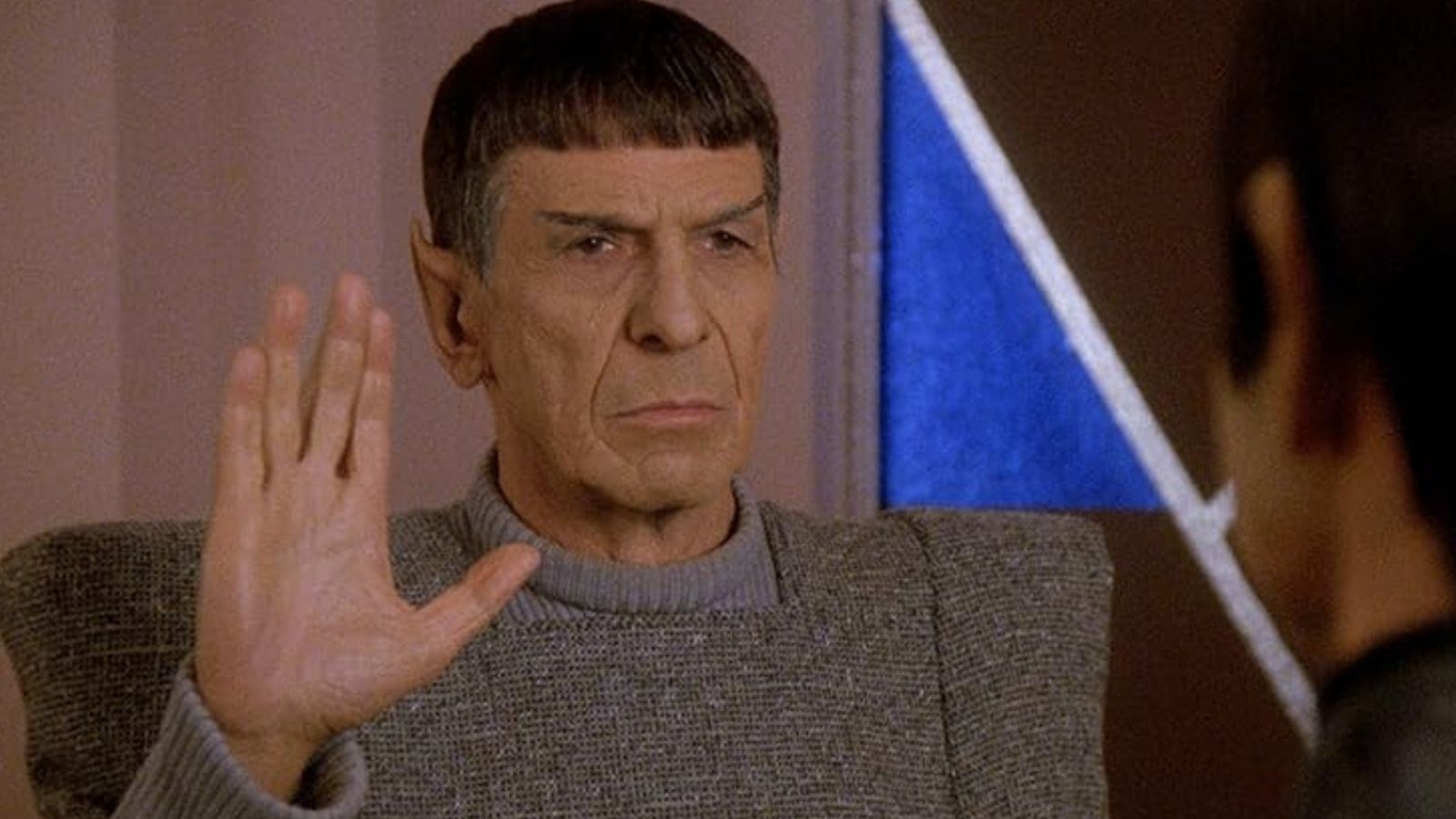
Spock Impressions
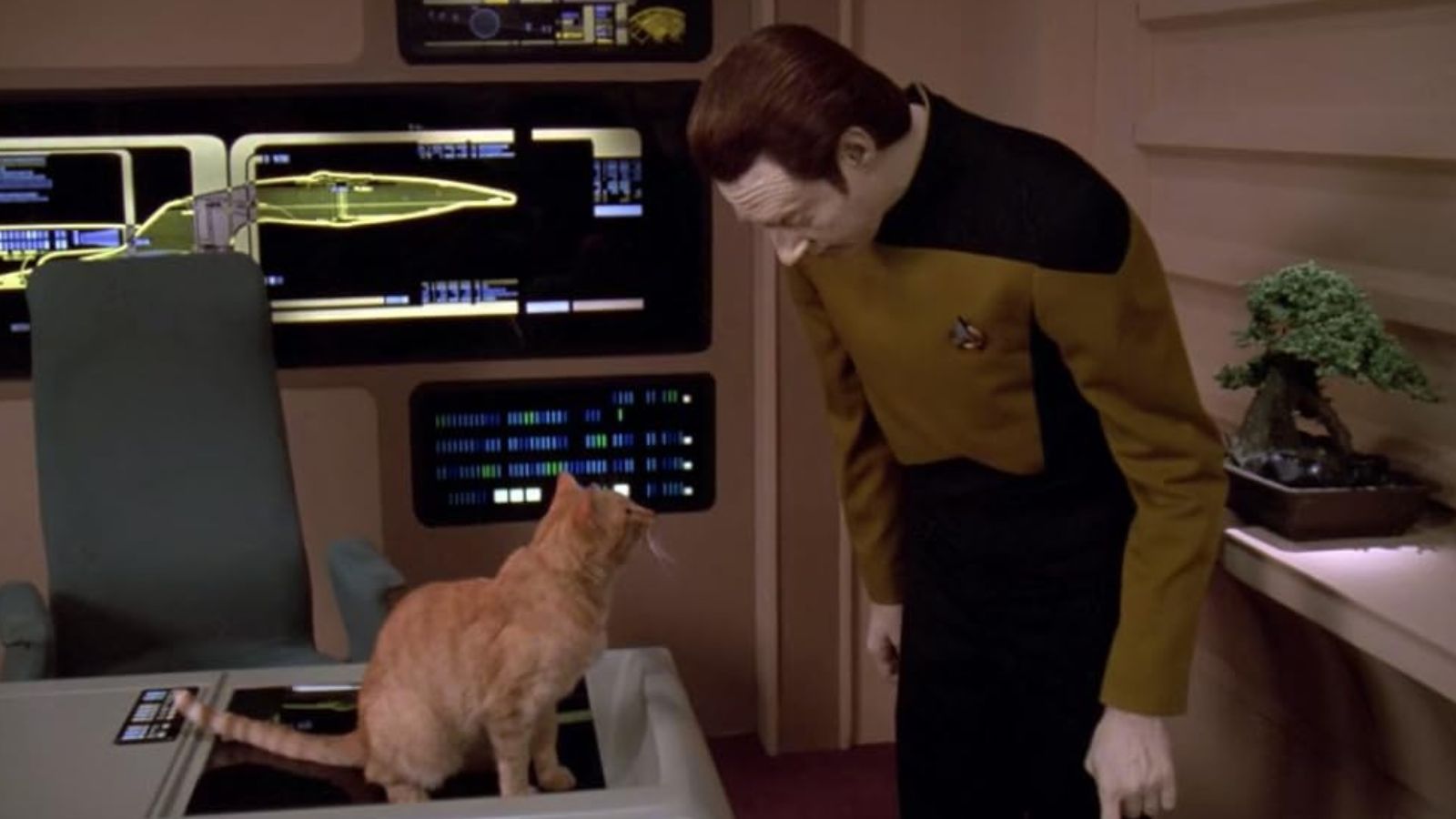
Some of the Tech from the Trek Has Already Become a Reality
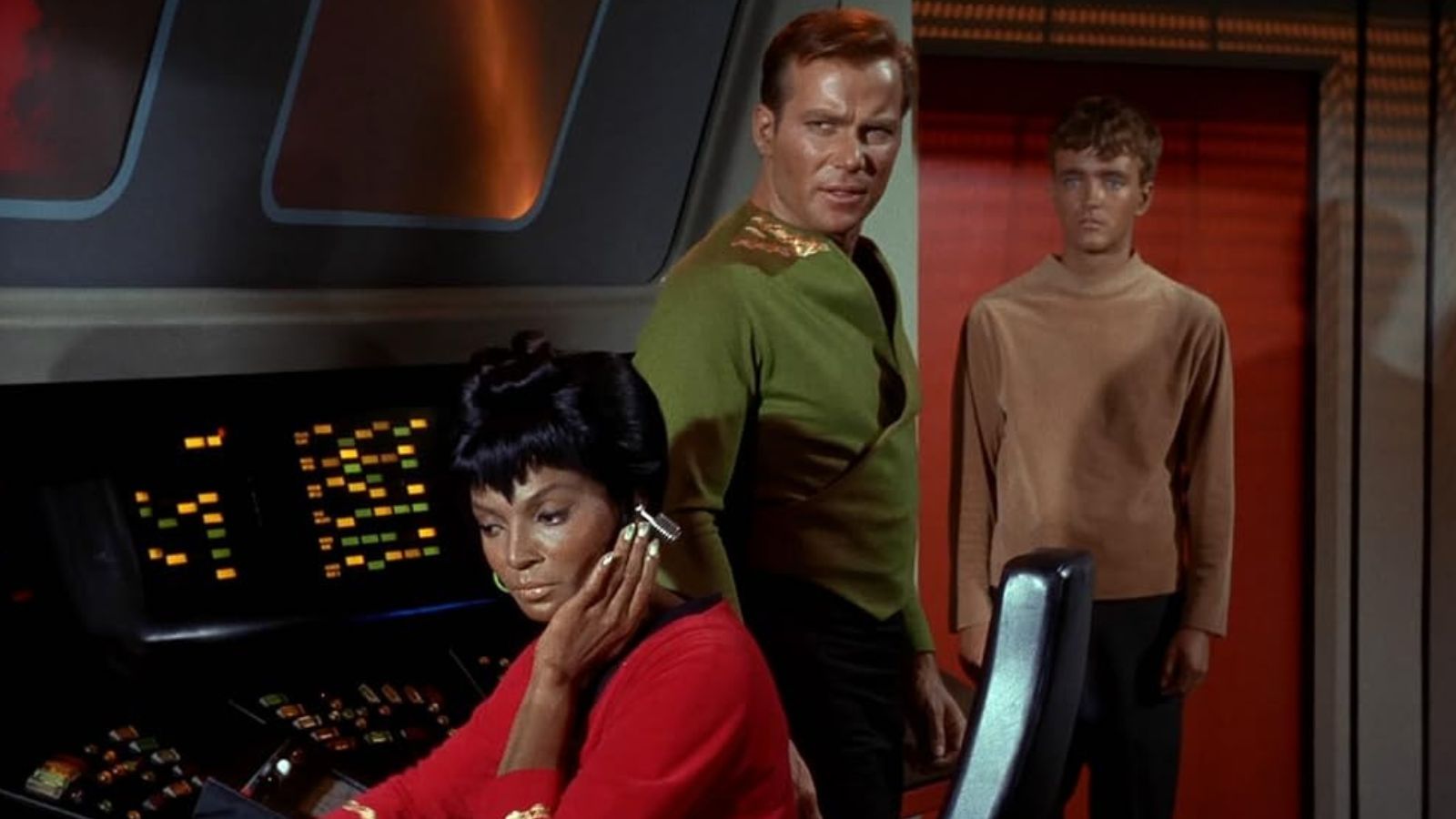
William Shatner and Leonard Nimoy Both Got Tinnitus
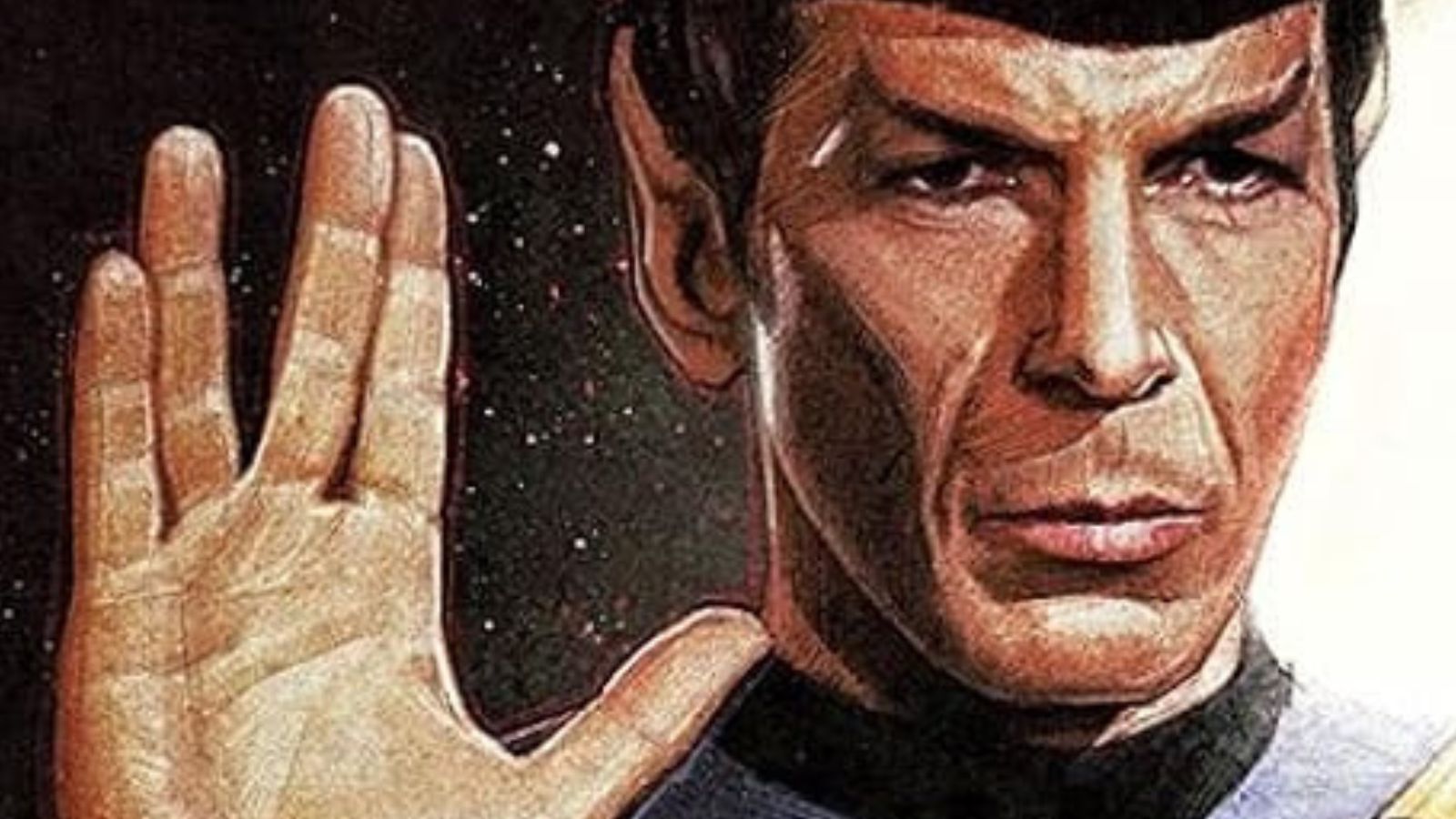
Spock’s Vulcan Salute is a Special Blessing in Hebrew
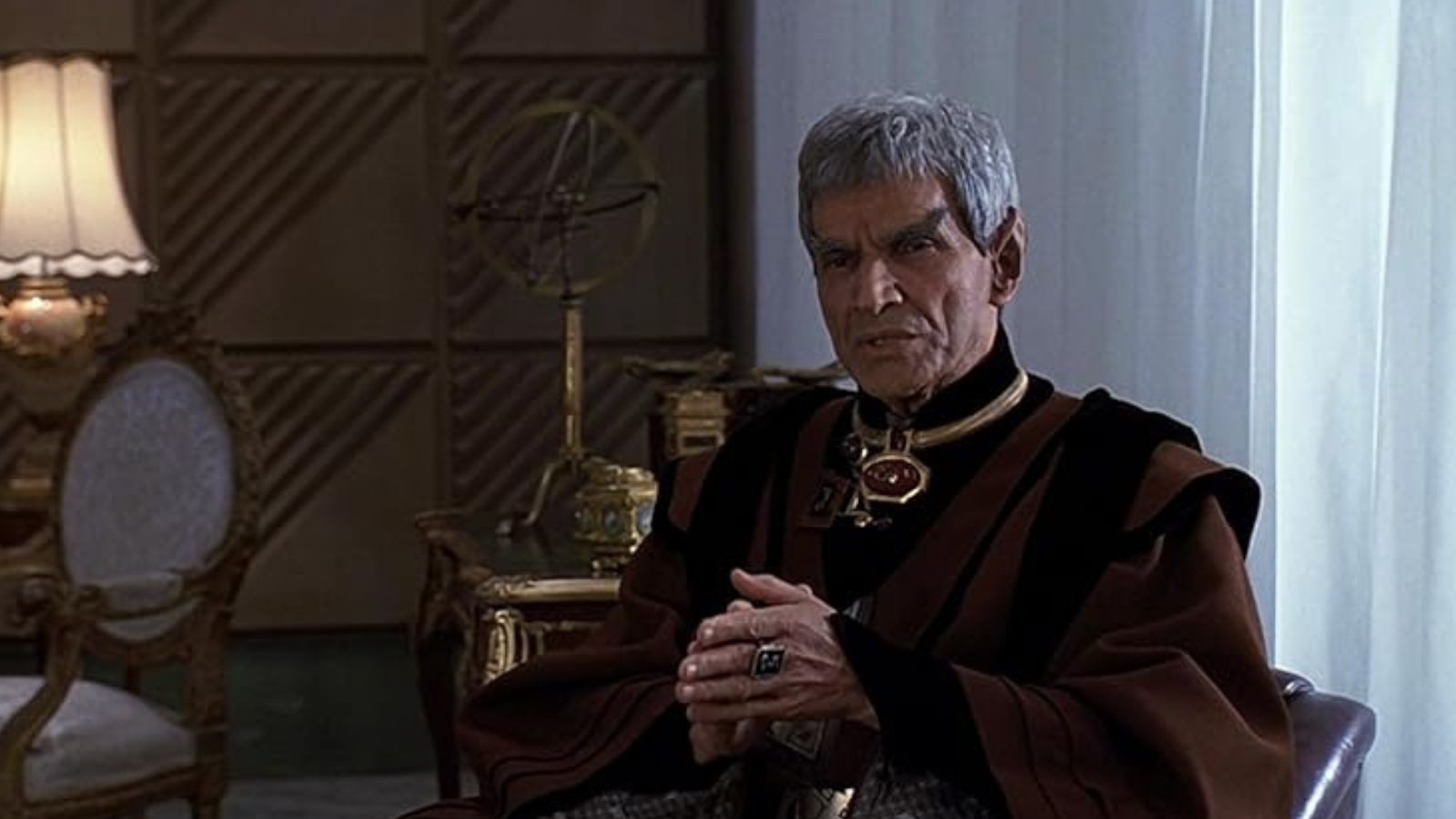
Star Trek Didn’t Only Recycle its Sets; It Also Recycled Actors
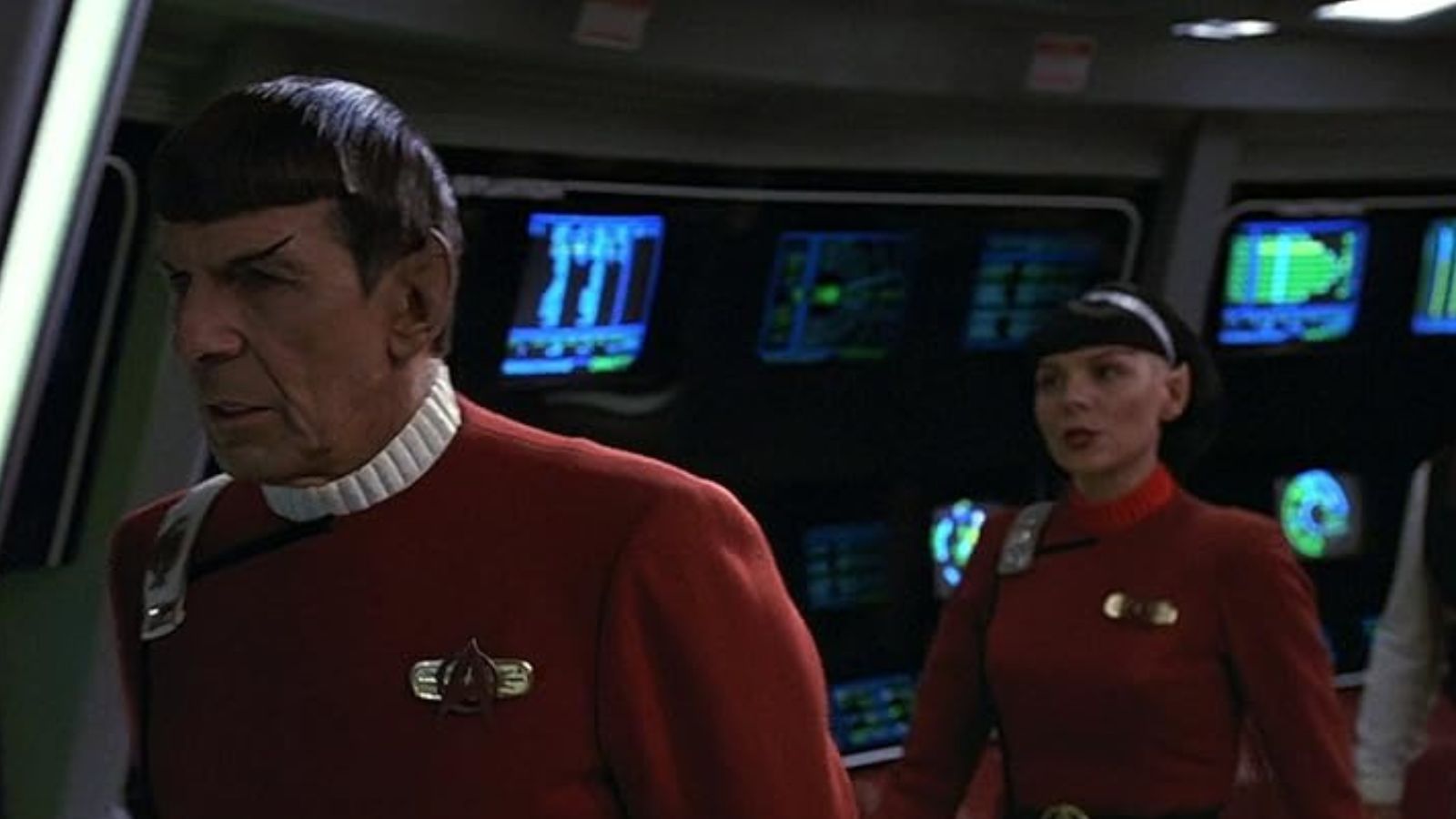
The Star Trek Brand Has Become Over-Commercialized
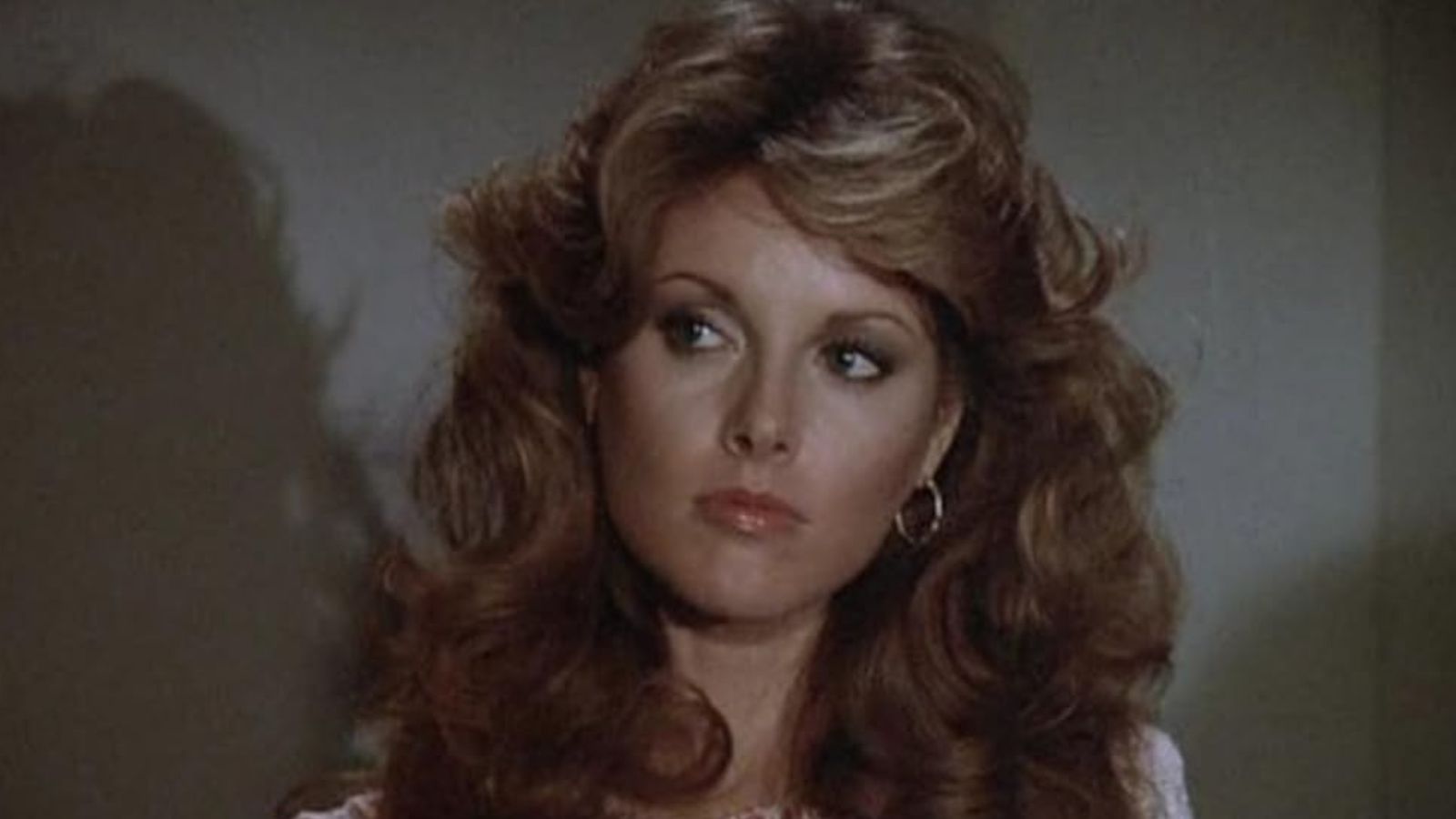
18 Formerly Beloved TV Shows That Would Flunk the Political Correctness Test Today
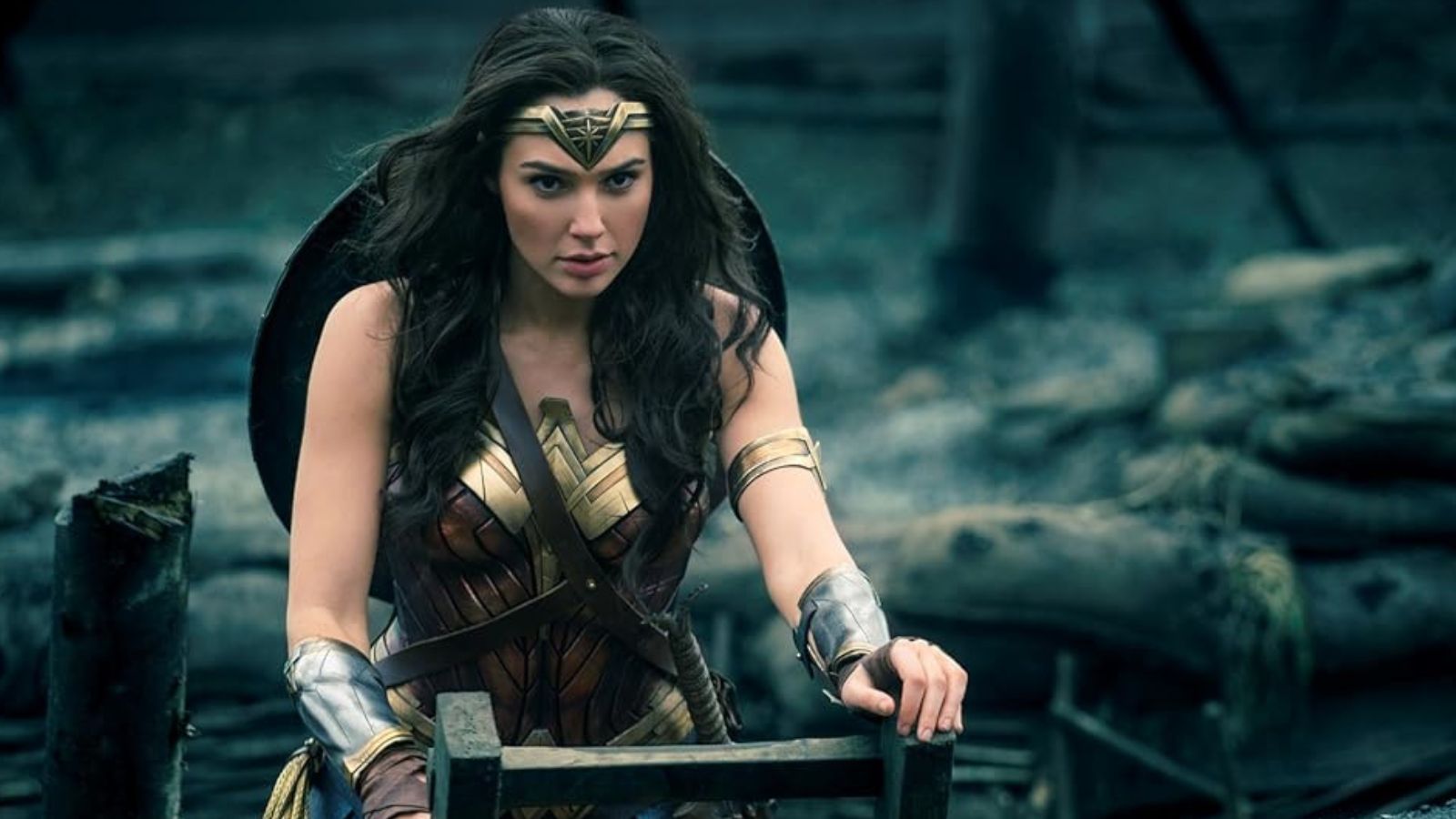
18 Films That Went Too Woke in the Last Decade

Empty Screens: 18 Movies Where Almost Nothing Really Happens
More for You
19 Things People Treat As Safe That Actually Are Pretty Dangerous
18 Most Common Reasons Women Leave Their Marriages
New contract makes Chiefs’ Travis Kelce highest paid tight end in the NFL, reps say
Democrats fume at Mike Johnson over antisemitism vote
28 celebrities you probably did not know are nonbinary
Barack Obama shares his No. 1 piece of advice for his own daughters: Don't let your hunger for success ruin your happiness
7 Things Stroke Doctors Say You Should Never, Ever Do
15 Traits Of An Alpha Female
The Most Common Last Name in Every Country, Mapped
Engineers Just Made Concrete 30% Stronger. The Secret Ingredient? Coffee.
29 common human foods you may not realize are poisonous to your dog
Marriage counsellor shares one sign your relationship is really over
The Choco Taco Is Coming Back For A Limited Time
How Much Beer You'd Have To Drink To Equal A Single Shot Of Liquor
Former world champion boxer Timothy Bradley predicts Mike Tyson will knock out Jake Paul in upcoming bout
A woman said her tattoos got her rejected for a job, but experts say personality is far more important
The best Vietnam War movie ever, based on data. Plus, find out the rest of the top 50.
If you and your partner use any of these 5 phrases regularly, your relationship is stronger than most
14 Social Phenomena Terms and Definitions We Didn't Even Know Existed
Graduation Season Is Here—Celebrate Your Student’s Milestone With These 25 Gifts Under $50

IMAGES
VIDEO
COMMENTS
Vulcan salute. The Vulcan salute is a hand gesture popularized by the 1960s television series Star Trek. It consists of a raised hand with the palm forward and the thumb extended, while the fingers are parted between the middle and ring finger. The gesture was devised by Star Trek actor Leonard Nimoy as a salute for the alien Vulcan species ...
Spock's hand sign on "Star Trek" has long been an iconic part of the franchise's lore, and it had a very personal meaning for his actor, Leonard Nimoy.
Vulcan salute. A Vulcan salute ( Star Trek: First Contact) For the DIS episode with a similar title, please see "The Vulcan Hello". The Vulcan salute was a hand gesture used by Vulcans. It involved holding the palm of one hand outwards while placing the fingers in a "V" shaped by separating the middle and ring fingers, while keeping the others ...
In 2012, StarTrek.com caught up with Nimoy to ask about the history behind the gesture and how it came to life on set. Inspired by a gesture he'd seen during a blessing at an orthodox Jewish shul as a boy, Nimoy carried the memory with him until the fateful day filming the scenes on Vulcan in "Amok Time.". "The idea came when I saw the ...
Vulcan finger-touching between Spock and a Romulan commander. Finger-touching at a Vulcan marriage ceremony. Saavik assisting the regenerated Spock to endure pon farr. Vulcan finger-touching was a ritualistic gesture among Vulcans involving the index and middle fingers. It was used throughout their culture, including in public as a greeting or to signify affection, intimacy, respect, or ...
The Vulcan salute went memetic almost immediately after Nimoy's first usage of the gesture. According to Nimoy, mere weeks after "Amok Time" aired, people were already using the gesture to greet him everywhere he went. The gesture was first popular among Star Trek fans but the gesture's similarity to the popular V-shaped peace hand gesture ( ️), both in finger placement and good ...
Takei, hating the restriction, plopped in his handprint anyway, and his fellow cast members immediately followed suit. Unbeknownst to many, Leonard Nimoy invented the Vulcan salute in Star Trek as ...
Aside from the pointed ears, Mr. Spock's Vulcan salute may be his most iconic feature. The gesture has become synonymous with Star Trek, to the point where fans use it as a standard greeting and subsequent sci-fi efforts like Mork and Mindy satirized it. There are even plans to build a statue honoring the salute in Nimoy's hometown of Boston. And yet, it was a late addition to the original ...
Nimoy introduced the hand sign of the Kohanim Jewish blessing, which would become the Vulcan salute. In a project for the Yiddish Book Center, Nimoy recounted the story of the first Star Trek episode where Spock visits the planet Vulcan in the Season 2 premiere, "Amok Time." Spock was to visit his home planet to be married, and it would be the ...
The history behind Leonard Nimoy's Vulcan salute. Live long and prosper. Leonard Nimoy's passing at the age of 83 is prompting a flood of reminiscences about the actor, artist, and poet best ...
The Vulcan salute in Star Trek has a profound meaning that connects to Leonard Nimoy's life. ... The hand sign invokes a letter of the Hebrew alphabet. Read Full Story.
The Hand Gesture in Canon. Back in the 1960s, hippies who watched Amok Time thought the salute was a variation of the two-fingered peace sign. But we Jews knew better. - Rabbi Yonassan Gershom. The Vulcan salute was performed in canon for the first time in the Star Trek: The Original Series episode "Amok Time."
As part of the Yiddish Book Center Wexler Oral History Project, Leonard Nimoy explains the origin of the Vulcan hand signal used by Spock, his character in the "Star Trek" series.
Leonard Nimoy, who played the overly logical part-human, part-Vulcan hero Spock on "Star Trek," passed away Friday at the age of 83. To quote Spock's most famous recurring line, Nimoy ...
1. "Live Long and Prosper". The Vulcan greeting and the finger-separating hand gesture that accompanies it first appeared in the second season of Star Trek: The Original Series, during an episode ...
The Star Trek hand symbol gained popularity through the Star Trek television series and subsequent movies. As the character of Mr. Spock became increasingly popular, so did his iconic gesture. Fans of the show began adopting the Vulcan salute as a way to express their love for the series and to identify themselves as Star Trek enthusiasts.
Leonard Nimoy (Beth Madison photo) "Liv e long and prosper." These words, along with the Vulcan salute, are immediately recognized and associated with Star Trek, which is celebrating the 53rd anniversary of its first episode this month.Their origins do not emanate from the vast final frontier, however, but rather from Leonard Nimoy's Jewish heritage.
The most famous Jewish influence on Vulcan culture in Star Trek is the "live long and prosper" hand gesture. This "Vulcan salute," as it has come to be called, was invented on the set by Leonard ...
But there's more. After some research, I discovered that the Vulcan sign used by Mr. Spock had a priestly background. Leonard Nimoy, who played Spock in the epic series, Star Trek, shared the history behind his famous hand sign. At about 8, Nimoy attended synagogue during the High Holy Days with his parents (Jewish immigrants from Ukraine).
The Corna. 4. The Pledge of Allegiance. 5. The High Five. 1. The Vulcan Salute. We all know it, even if we can't all do it. The Vulcan Salute, made famous by Leonard Nimoy as Mr. Spock on the ...
Spock was also from an alien type father who was a Vulcan and his mother was human. It was the character of Spock introduced the Hebrew sign for the letter Shin (שׁ), an emblem for Shaddai, "Almighty [God]" as the salutary Vulcan hand signal used for greeting others. In addition, Spock was a scientist who worked with healers and the ...
Actor, Leonard Nimoy who plays Spock, actually grew up in Boston. It was Nimoy that brought this hand gesture to Star Trek. According to StarTrek.com …Google Alert - "Star Trek" Read More
Response: Yes, the Vulcan salute is an authentic imitation of the manner by which Cohanim spread their hands in most congregations when blessing the congregation to this day. Cohanim are those people that today comprise about four to five percent of the Jewish population, 1 all of whom trace their paternal lineage back to Aaron, brother of ...
In Star Trek: Discovery season 5, episode 5, "Mirrors," Captain Burnham and Cleveland Booker (David Ajala) follow couriers Moll (Eve Harlow) and L'ak (Elias Toufexis) into interdimensional space in search of the next clue leading to the Progenitors' treasure.Once there, they find the damaged ISS Enterprise, which holds clues about the fate of Mirror Universe Spock and his crew.
In 1995, Captain Janeway took over our screens as the first female lead of Star Trek Voyager, boldly going where no man (or woman) had gone before.There was a massive backlash from fans and the ...